Digital television transition
The digital television transition, also called the digital switchover (DSO), the analog switch-off (ASO), the digital migration, or the analog shutdown, is the process in which older analog television broadcasting technology is converted to and replaced by digital television. Conducted by individual nations on different schedules, this primarily involves the conversion of analog terrestrial television broadcasting infrastructure to digital terrestrial (DTT), a major benefit being extra frequencies on the radio spectrum and lower broadcasting costs, as well as improved viewing qualities for consumers.

Transition completed; all analog signals terminated
Transition almost completed; most analog signals terminated
Transition in progress; broadcasting both analog and digital signals
Transition has not been planned or started, or is in early stages
No digital switchover planned, broadcasting both analog and digital signals
The transition may also involve analog cable conversion to digital cable or internet protocol television, as well as analog to digital satellite television. Transition of land based broadcasting was begun by some countries around 2000. By contrast, transition of satellite television systems was well underway or completed in many countries by this time. It is an involved process because the existing analog television receivers owned by viewers cannot receive digital broadcasts; viewers must either purchase new digital TVs, or converter boxes which change the digital signal to an analog signal or some other form of a digital signal (i.e. HDMI) which can be received on the older TV. Usually during a transition, a simulcast service is operated where a broadcast is made available to viewers in both analog and digital at the same time. As digital becomes more popular, it is expected that the existing analog services will be removed. In most places this has already happened, where a broadcaster has offered incentives to viewers to encourage them to switch to digital. Government intervention usually involves providing some funding for broadcasters and, in some cases, monetary relief to viewers, to enable a switchover to happen by a given deadline. In addition, governments can also have a say with the broadcasters as to what digital standard to adopt - either DVB-T, ATSC, ISDB-T, or DTMB. Governments can also require all receiving equipment sold in a country to support the necessary digital 'tuner'.
Before digital television, PAL and NTSC were used for both video processing within TV stations and for broadcasting to viewers. Because of this, the switchover process may also include the adoption of digital equipment utilizing Serial digital interface (SDI) on TV stations, replacing analog PAL or NTSC component or composite video equipment. Digital broadcasting standards are only used to broadcast video to viewers; Digital TV stations usually use SDI irrespective of broadcast standard, although it might be possible for a station still using analog equipment to convert its signal to digital before it is broadcast, or for a station to use digital equipment but convert the signal to analog for broadcasting, or they may have a mix of both digital and analog equipment. Digital TV signals require less transmission power to be broadcast and received satisfactorily.[1]
The switchover process is being accomplished on different schedules in different countries; in some countries it is being implemented in stages as in Australia, India or Mexico, where each region has a separate date to switch off. In others, the whole country switches on one date, such as the Netherlands.[2] On 3 August 2003, Berlin became the world's first city to switch off terrestrial analog signals.[3] Luxembourg was the first country to complete its terrestrial switchover, in September 2006.[4]
Background and timeline
Planned transition dates:
- 1996: Netherlands (satellite services)
- 1998: United Kingdom (digital terrestrial service)
- 1999: Russia (satellite services)
- 2001: United Kingdom/Republic of Ireland (satellite services), Malaysia (cable television)
- 2002: Faroe Islands, Malaysia (satellite services), Albania (satellite services), Norway (satellite services)
- 2004: Sweden (satellite services)
- 2005: Italy (satellite services), Indonesia (satellite services)
- 2006: Turkey (satellite services), China (satellite services), Luxembourg, Netherlands
- 2007: Finland, Andorra, Sweden, Switzerland
- 2008: Germany, Belgium (Flanders)
- 2009: United States (full power stations), Isle of Man, Denmark, Norway
- 2010: Belgium (Wallonia), Croatia, Estonia, Guernsey, Jersey, Japan (northeastern Ishikawa Prefecture only), Latvia, Luxembourg (cable television and satellite), San Marino, Slovenia, Spain, United Kingdom (Wales)
- 2011: Austria, Canada (major markets), Cyprus, France, Israel, Japan (except 2011 Tōhoku earthquake-affected prefectures), Malta, Monaco, United Kingdom (Scotland)
- 2012: Czech Republic, Gibraltar, Germany (satellite services), Republic of Ireland (terrestrial), Italy, Japan (Fukushima, Iwate, Miyagi Prefectures), Lithuania, Saudi Arabia, Qatar, United Arab Emirates, Jordan, Bahrain, Portugal, Slovakia, South Korea, Taiwan, United Kingdom (England and Northern Ireland), Vatican City
- 2013: Australia, Azerbaijan, Bulgaria, Hungary, North Macedonia, Mauritius, New Zealand, Poland, United Kingdom (cable television)
- 2014: Serbia, Iceland, Namibia, Algeria
- 2015: Belarus, Brunei, Greece, Iran, Morocco (UHF band), Mexico, Moldova, Romania (UHF band), Rwanda, Kenya, Uganda, Ghana, Georgia, United States (class A low-power stations), Mongolia[5]
- 2016: Bermuda, Brazil (Federal District and the city of Rio Verde, Goiás), Chile, China (CCTV), Burundi
- 2017: Brazil (a few metropolitan areas, such as São Paulo and Rio de Janeiro, among others), Philippines (Light Network), Romania (phase 2), Germany Unitymedia, Kyrgyzstan, Brunei[6]
- 2018: Brazil (major markets, including all markets in Rio de Janeiro, São Paulo states), Romania (VHF band),[7] Russia (First Two Multiplex Channels) (Tver Region), Thailand (most channels), Ukraine (most channels), Uzbekistan, Philippines (RJ TV/2nd Avenue)
- 2019: Bolivia, Republic of Ireland (cable television), Russia (First Two Multiplex Channels) (more regions), Northern Cyprus, Singapore,[8][9] India (phase one), Moldova (Transnistria), Bhutan (cable television),[10] Peru (Lima and Callao), Costa Rica, Malaysia (terrestrial)[11][12][13]
- 2020: Brazil (other markets), Morocco (VHF band), Hong Kong, Macau, Thailand (Channel 3),[14] Venezuela, Moldova (Other territories), Sudan, Côte d’Ivoire, Vietnam,[15][16] Laos,[17] Pakistan,[18] Senegal
- 2021: Dominican Republic,[19] China (regional stations), United States (low-power stations), India (phase two), Colombia,[20] Argentina,[21] Kazakhstan, Paraguay, Panama (Panamá, Colón and Panamá Oeste), South Africa,[22] Indonesia (Jakarta)[23]
- 2022: Canada (remaining markets), El Salvador, Indonesia (rest of country)[24]
- 2023: Brazil (rural areas), Cambodia,[25] Cuba, Philippines (remaining markets),[26] India (last phase), Peru (rest of country)
- 2024: Botswana
- Multiple dates: Ethiopia, Angola
Digital standards
Different standards have been developed for the broadcast transmission of digital terrestrial television, comparable to the older analog standards they replace: NTSC, PAL and SECAM. Broadcasters around the world choose and adopt one of these to be the format and technology behind the transmission. The standards are:
- The European-made DVB-T, adopted by most of Europe, Africa, Asia and Oceania
- The American-made ATSC, adopted by much of the Americas and some of Asia and Oceania
- The Japanese-made ISDB-T, adopted by some in Asia, most of South America, and a few in Africa
- The Chinese-made DTMB, adopted by some in Asia and a few in Africa and the Americas
2006 Geneva Agreement
The "RRC-06" agreement in Geneva (hosted by the International Telecommunication Union (ITU)) was signed by delegates from many countries, including most of Europe, Africa and Asia. The agreement set 17 June 2015 as the date after which countries may use frequencies currently assigned for analog television transmission for digital services (specifically DVB-T), without being required to protect the analog services of neighbouring countries against interference. This date was generally viewed as an internationally mandated analog switch-off date, at least along national borders[27]—except for those operating on the VHF band which would be allowed until 17 June 2020.[28]
These deadlines set by the agreement have been difficult to reach in certain regions, like in Africa where most countries missed the 2015 deadline,[29] as well as South East Asia.[30] High upgrade costs are often a reason cited to the slow transition in those regions.
The European Commission, on a different note, had recommended on 28 October 2009 that digital switchover should be completed by 1 January 2012.[31]
Digital-to-analog converters
Analog only TVs are incapable of receiving over-the-air broadcasts without the addition of a set-top converter box. Consequently, a digital converter box – an electronic device that connects to an analog television – must be used in order to allow the television to receive digital broadcasts. In the United States, the government subsidized the purchase of such boxes for consumers via their coupon-eligible converter box program in 2009, funded by a small part of the billions of dollars brought in by a spectrum auction. The program was managed by the Department of Commerce through its National Telecommunications and Information Administration.
Televisions with integrated digital tuners have been available for a considerable time. This means that the need for a set-top box is usually no longer necessary with a new TV set.
Satellite and cable
Satellite broadcasting switched to digital much earlier than terrestrial broadcasting. The switchover process is much easier for satellite since only changes to the earth station equipment are needed on the transmission side and consumers are already used to having a set top box/decoder. In many places, the satellite switchover was complete before terrestrial switchover was even started. Cable on the other hand would switch off months, if not years after terrestrial would.
In countries where terrestrial is little used, the migration to digital satellite or cable is more realized. For instance, in Switzerland or the UAE, where terrestrial has low usage, the terrestrial switchover was not noticed by the general population. But in countries where terrestrial is the dominant method of watching TV, like Japan, Spain or Thailand, the switchover is a big deal as it affects the majority of the population.
Terrestrial digital switchover by country, at a glance
Transitions completed
Africa
 Algeria: Digital broadcasting started in 2009, analog signals were switched off on 10 November 2014.[32]
Algeria: Digital broadcasting started in 2009, analog signals were switched off on 10 November 2014.[32] Cape Verde started transitioning to digital in the early 2010s.[33] The analog switch off happened to complete at the end of 2019.[34]
Cape Verde started transitioning to digital in the early 2010s.[33] The analog switch off happened to complete at the end of 2019.[34] Eswatini: The switchover is complete.[35]
Eswatini: The switchover is complete.[35] Gabon had turned off all analog signals on 17 June 2016.[36]
Gabon had turned off all analog signals on 17 June 2016.[36] Ghana: Analog switch-off occurred in June 2015, switching to DVB-T.[37]
Ghana: Analog switch-off occurred in June 2015, switching to DVB-T.[37] Ivory Coast: Launched its DTV service from the Centre Émetteur D'Abobo site in Abidjan on 8 February 2019. Côte d'Ivoire has completed the migration to DTT in June 2020.
Ivory Coast: Launched its DTV service from the Centre Émetteur D'Abobo site in Abidjan on 8 February 2019. Côte d'Ivoire has completed the migration to DTT in June 2020. Kenya: After DTT launched in 2008, analog switch off was supposed to take place in 2013, however media houses challenged the move in court and the switch off has since been moved to 31 December 2014 for the metropolitan areas and their surroundings while in the rest of the country switched to DVB-T2 in March 2015.
Kenya: After DTT launched in 2008, analog switch off was supposed to take place in 2013, however media houses challenged the move in court and the switch off has since been moved to 31 December 2014 for the metropolitan areas and their surroundings while in the rest of the country switched to DVB-T2 in March 2015. Lesotho: The switchover is complete.[35]
Lesotho: The switchover is complete.[35] Libya 7 multiplexes of DVB-T2 were available in Tripoli in 2012. Analog television was turned off on 13 February 2020.
Libya 7 multiplexes of DVB-T2 were available in Tripoli in 2012. Analog television was turned off on 13 February 2020. Malawi: The switchover is complete.[35]
Malawi: The switchover is complete.[35]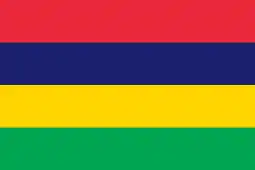 Mauritius: First digital (DVB-T) broadcasts commenced 30 September 2005.[38] Analog shut off on 17 June 2014.[39]
Mauritius: First digital (DVB-T) broadcasts commenced 30 September 2005.[38] Analog shut off on 17 June 2014.[39] Namibia: The first African country to go digital when it launched DTT in February 2005.[40] Analog signals were terminated on 13 September 2014.
Namibia: The first African country to go digital when it launched DTT in February 2005.[40] Analog signals were terminated on 13 September 2014. Rwanda: Shut off the last of its analog signals in March 2014. Switched to DVB-T,[39] with plans to upgrade to DVB-T2 in the future.[41]
Rwanda: Shut off the last of its analog signals in March 2014. Switched to DVB-T,[39] with plans to upgrade to DVB-T2 in the future.[41] South Africa The Northern Cape became the first province to switch fully to digital in December 2018.[42][43][44][45] After many delays of the ASO, it is finally completed in July 2020.[46]
South Africa The Northern Cape became the first province to switch fully to digital in December 2018.[42][43][44][45] After many delays of the ASO, it is finally completed in July 2020.[46] Sudan is broadcasting a number of multiplexes in DVB-T2 (SD & HD) from the nationwide of Sudan TV since late 2015. A single analogue UHF channel remains. Analog television has been turned off on 13 February 2020.
Sudan is broadcasting a number of multiplexes in DVB-T2 (SD & HD) from the nationwide of Sudan TV since late 2015. A single analogue UHF channel remains. Analog television has been turned off on 13 February 2020. Tanzania: Shut off the last of its analog signals in July 2014. Switched to DVB-T2[39][47]
Tanzania: Shut off the last of its analog signals in July 2014. Switched to DVB-T2[39][47] Uganda: Shut off analog signals in 2015.[48]
Uganda: Shut off analog signals in 2015.[48] Zambia: Analog shut off on 31 December 2014. Switched to DVB-T2.[49][50]
Zambia: Analog shut off on 31 December 2014. Switched to DVB-T2.[49][50]
Americas
 Bermuda: The Bermuda Broadcasting Company terminated terrestrial NTSC-M broadcasts in March 2016. ZFB-TV (analog channel 7) and ZBM-TV (analog channel 9), the two television stations in Bermuda, have now switched to digital channels 20.1 and 20.2, respectively.[51] Like its parent nation (the United Kingdom) and unlike the United States, Canada and the Bahamas (which have been transitioning to ATSC), Bermuda switched over to DVB-T.
Bermuda: The Bermuda Broadcasting Company terminated terrestrial NTSC-M broadcasts in March 2016. ZFB-TV (analog channel 7) and ZBM-TV (analog channel 9), the two television stations in Bermuda, have now switched to digital channels 20.1 and 20.2, respectively.[51] Like its parent nation (the United Kingdom) and unlike the United States, Canada and the Bahamas (which have been transitioning to ATSC), Bermuda switched over to DVB-T. Costa Rica: The transition is complete. The country was scheduled to shut down analog signals permanently in December 2018 but this was changed to 15 August 2019.
Costa Rica: The transition is complete. The country was scheduled to shut down analog signals permanently in December 2018 but this was changed to 15 August 2019. Falkland Islands has digital TV through KTV and British Forces Broadcasting Service, which since the early 2010s now exclusively broadcast digitally.[52]
Falkland Islands has digital TV through KTV and British Forces Broadcasting Service, which since the early 2010s now exclusively broadcast digitally.[52] Honduras: First phase began on 31 December 2016, second phase has been completed on 31 December 2019.[53] The whole country is now entirely covered by DTV.
Honduras: First phase began on 31 December 2016, second phase has been completed on 31 December 2019.[53] The whole country is now entirely covered by DTV. Mexico: Digital broadcasts started in 2000, with the first being Tijuana's XETV – an English-language television station that primarily served San Diego, California between the 1960s and the early 2010s. Analog shutdown was originally scheduled to occur in 2012, but on Thursday, 2 September 2010, Mexican government advanced the analog shutdown from 2012 to 2015.[54] From 2013, areas began to be switched over regionally depending on the presence of digital terrestrial stations and a campaign headed by the SCT to distribute free television converters to households on the government welfare rolls. The first digital switchover was to begin on Tuesday, 28 May 2013 in Tijuana, but was postponed to 18 July due to the 2013 Baja California state elections.[55] The switchover was completed nationwide on 31 December 2015, when all remaining analog television stations left the air.[56] Mexico then instituted a nationwide remapping of network stations in late 2015 requiring most of them to map to the channel number in either Mexico City, or for regional networks, the main metro area served by the network's flagship station.
Mexico: Digital broadcasts started in 2000, with the first being Tijuana's XETV – an English-language television station that primarily served San Diego, California between the 1960s and the early 2010s. Analog shutdown was originally scheduled to occur in 2012, but on Thursday, 2 September 2010, Mexican government advanced the analog shutdown from 2012 to 2015.[54] From 2013, areas began to be switched over regionally depending on the presence of digital terrestrial stations and a campaign headed by the SCT to distribute free television converters to households on the government welfare rolls. The first digital switchover was to begin on Tuesday, 28 May 2013 in Tijuana, but was postponed to 18 July due to the 2013 Baja California state elections.[55] The switchover was completed nationwide on 31 December 2015, when all remaining analog television stations left the air.[56] Mexico then instituted a nationwide remapping of network stations in late 2015 requiring most of them to map to the channel number in either Mexico City, or for regional networks, the main metro area served by the network's flagship station. Puerto Rico Complied with the FCC transition to ATSC digital on 12 June 2009 on all full-power stations.[57][58]
Puerto Rico Complied with the FCC transition to ATSC digital on 12 June 2009 on all full-power stations.[57][58] Suriname adopted the ATSC standard for DTT and completed the analog switch off in 2015.[59]
Suriname adopted the ATSC standard for DTT and completed the analog switch off in 2015.[59] U.S. Virgin Islands Complied with the FCC transition to ATSC digital on 12 June 2009 on all full-power stations.
U.S. Virgin Islands Complied with the FCC transition to ATSC digital on 12 June 2009 on all full-power stations.
Asia
 Bahrain: The analog terrestrial transmissions were terminated on Monday, 13 February 2012 and was replaced by a multiplex for Nilesat. The government plans to shut off analog cable by 31 March 2023. Bahrain was transitioning from using MPEG-2 to MPEG-4 for its terrestrial broadcasts, a process which began on Sunday, 26 August 2012. Bahrain adopted DVB-T2 in March 2013. Analog satellite transmission were switched off on Monday, 1 March 2004. Digital television launched terrestrially throughout Arab world on Thursday, 20 September 2007 (known as Nilesat).
Bahrain: The analog terrestrial transmissions were terminated on Monday, 13 February 2012 and was replaced by a multiplex for Nilesat. The government plans to shut off analog cable by 31 March 2023. Bahrain was transitioning from using MPEG-2 to MPEG-4 for its terrestrial broadcasts, a process which began on Sunday, 26 August 2012. Bahrain adopted DVB-T2 in March 2013. Analog satellite transmission were switched off on Monday, 1 March 2004. Digital television launched terrestrially throughout Arab world on Thursday, 20 September 2007 (known as Nilesat). British Indian Ocean Territory: Military broadcaster BFBS is operating fully on digital.[60]
British Indian Ocean Territory: Military broadcaster BFBS is operating fully on digital.[60] Brunei: The country selected the standard of DVB-T2 with first launch in 2014. Full transition to digital terrestrial television broadcasting were completed on 31 December 2017.[6]
Brunei: The country selected the standard of DVB-T2 with first launch in 2014. Full transition to digital terrestrial television broadcasting were completed on 31 December 2017.[6] Hong Kong: The original digital switchover plan from PAL to DTMB was supposed to take place in 2012.[61] After being postponed multiple times, analogue broadcasting officially ended from 30 November 2020 at 23:59 HKT, when all analogue transmissions turned off.[62] A total of 160,000 lower-income households are also to receive subsidies from the government to buy digital television sets or a set-top box to get a digital signal following the transition.[63]
Hong Kong: The original digital switchover plan from PAL to DTMB was supposed to take place in 2012.[61] After being postponed multiple times, analogue broadcasting officially ended from 30 November 2020 at 23:59 HKT, when all analogue transmissions turned off.[62] A total of 160,000 lower-income households are also to receive subsidies from the government to buy digital television sets or a set-top box to get a digital signal following the transition.[63] Israel: started digital transmissions in MPEG-4 on Sunday 2 August 2009 and analog transmissions ended on Thursday 31 March 2011. A second MUX in DVB-T2 was launched in August 2015.
Israel: started digital transmissions in MPEG-4 on Sunday 2 August 2009 and analog transmissions ended on Thursday 31 March 2011. A second MUX in DVB-T2 was launched in August 2015.

 Japan: The analog shutdown began on 24 July 2010 in Suzu, Ishikawa as a pilot experiment.[64] Analog terrestrial television transmissions in the remainder of Ishikawa Prefecture and 43 other prefectures, as well as analog Broadcast Satellite and Wowow services, ended at noon on Sunday 24 July 2011, along with the analog satellite services; three remaining prefectures (Fukushima, Iwate, and Miyagi) that were destroyed or heavily damaged in the 11 March 2011 9.0 magnitude Tohoku earthquake and its related nuclear accidents stopped analog broadcasting at noon on Saturday, 31 March 2012.[65] In both of those cases, the analog transmitters themselves were switched off at midnight on the same day. Analog high-definition television broadcasting ended on Sunday, 30 September 2007.[66] An analog cable service (known as Dejiana since 1 July 2011) continued to be broadcast, but starting on 1 April 2012, all cable providers in Japan were required to convert from analog to digital services. Most analog cable services were terminated between 24 July 2011 and April 2015.[67] All television stations across the country are now broadcasting only in digital, ending an analog-digital simulcast period that began on Monday 1 December 2003 in the Kantō region (which expanded to all other prefectures over the next four years) and ended between 24 July 2011 and 31 March 2012 (when all analog transmissions were shut down).
Japan: The analog shutdown began on 24 July 2010 in Suzu, Ishikawa as a pilot experiment.[64] Analog terrestrial television transmissions in the remainder of Ishikawa Prefecture and 43 other prefectures, as well as analog Broadcast Satellite and Wowow services, ended at noon on Sunday 24 July 2011, along with the analog satellite services; three remaining prefectures (Fukushima, Iwate, and Miyagi) that were destroyed or heavily damaged in the 11 March 2011 9.0 magnitude Tohoku earthquake and its related nuclear accidents stopped analog broadcasting at noon on Saturday, 31 March 2012.[65] In both of those cases, the analog transmitters themselves were switched off at midnight on the same day. Analog high-definition television broadcasting ended on Sunday, 30 September 2007.[66] An analog cable service (known as Dejiana since 1 July 2011) continued to be broadcast, but starting on 1 April 2012, all cable providers in Japan were required to convert from analog to digital services. Most analog cable services were terminated between 24 July 2011 and April 2015.[67] All television stations across the country are now broadcasting only in digital, ending an analog-digital simulcast period that began on Monday 1 December 2003 in the Kantō region (which expanded to all other prefectures over the next four years) and ended between 24 July 2011 and 31 March 2012 (when all analog transmissions were shut down). Kyrgyzstan: DTT services rolled out officially in 2014, and the transition to digital ended in 2017.[68]
Kyrgyzstan: DTT services rolled out officially in 2014, and the transition to digital ended in 2017.[68] Malaysia: Early DTT broadcasts were rolled out in January 2014 starting in selected test areas, while full nationwide coverage to an estimated 98% populated areas was expected by the end of the analogue-digital simulcast period.[69][70] The official launch of digital broadcasts was on 6 June 2017 by the Prime Minister with an estimation of 4.2 million digital television decoders were to be given free to citizens, including recipients of the government aid of 1Malaysia People's Aid (BR1M).[71] The Malaysian Communications and Multimedia Ministry (MCMM) further stated that analogue broadcasting throughout Malaysia will be turned off completely in September 2019 with full digital television broadcasting available by October.[11][12][13] Langkawi was the first area to commence the digital switchover on 21 July 2019 at 02:30 AM (UTC+8).[72] Later, on 6 August 2019, MCMM released the complete list of transition date on the remaining areas.[73] The Malaysian Communications and Multimedia Commission (MCMC) announced in late September that the full digital transition was to be completed on 31 October 2019.[74] The switchover was scheduled with central and southern West Malaysia on 30 September, northern and eastern coasts of West Malaysia on 14 October and entire East Malaysia on 31 October.[75] The digital transition in West Malaysia was completed on 15 October 2019 at 12:30 AM with East Malaysia later on 31 October 2019 also at 12:30 AM.[76][77][78][79][80]
Malaysia: Early DTT broadcasts were rolled out in January 2014 starting in selected test areas, while full nationwide coverage to an estimated 98% populated areas was expected by the end of the analogue-digital simulcast period.[69][70] The official launch of digital broadcasts was on 6 June 2017 by the Prime Minister with an estimation of 4.2 million digital television decoders were to be given free to citizens, including recipients of the government aid of 1Malaysia People's Aid (BR1M).[71] The Malaysian Communications and Multimedia Ministry (MCMM) further stated that analogue broadcasting throughout Malaysia will be turned off completely in September 2019 with full digital television broadcasting available by October.[11][12][13] Langkawi was the first area to commence the digital switchover on 21 July 2019 at 02:30 AM (UTC+8).[72] Later, on 6 August 2019, MCMM released the complete list of transition date on the remaining areas.[73] The Malaysian Communications and Multimedia Commission (MCMC) announced in late September that the full digital transition was to be completed on 31 October 2019.[74] The switchover was scheduled with central and southern West Malaysia on 30 September, northern and eastern coasts of West Malaysia on 14 October and entire East Malaysia on 31 October.[75] The digital transition in West Malaysia was completed on 15 October 2019 at 12:30 AM with East Malaysia later on 31 October 2019 also at 12:30 AM.[76][77][78][79][80]
 Mongolia: The country selected the standard of DVB-T2 with first launch in 2014. Full transition to digital terrestrial television broadcasting were completed in 2015.[5]
Mongolia: The country selected the standard of DVB-T2 with first launch in 2014. Full transition to digital terrestrial television broadcasting were completed in 2015.[5] South Korea: Digital switchover progressed region–by–region, with the first analog transmitters in Uljin, North Gyeongsang Province ending transmissions on Wednesday, 1 September 2010.[81] Analog broadcasting official officially ended Monday 31 December 2012 at 04:00 KST when the analog cable television and analog transmitters in Seoul, Gyeonggi Province and Incheon ended transmissions. A few border analog transmitters targeting North Korea were switched off in June 2015.[82]
South Korea: Digital switchover progressed region–by–region, with the first analog transmitters in Uljin, North Gyeongsang Province ending transmissions on Wednesday, 1 September 2010.[81] Analog broadcasting official officially ended Monday 31 December 2012 at 04:00 KST when the analog cable television and analog transmitters in Seoul, Gyeonggi Province and Incheon ended transmissions. A few border analog transmitters targeting North Korea were switched off in June 2015.[82] Qatar: The analog terrestrial transmissions were terminated on Monday, 13 February 2012 and was replaced by a multiplex for Nilesat. The government plans to shut off analog cable by 31 March 2023. Qatar was transitioning from using MPEG-2 to MPEG-4 for its terrestrial broadcasts, a process which began on Sunday, 26 August 2012. Qatar adopted DVB-T2 in February 2013. Analog satellite transmission were switched off on Monday, 1 March 2004. Digital television launched terrestrially throughout Arab world on Monday, 1 January 2001 (known as Nilesat).
Qatar: The analog terrestrial transmissions were terminated on Monday, 13 February 2012 and was replaced by a multiplex for Nilesat. The government plans to shut off analog cable by 31 March 2023. Qatar was transitioning from using MPEG-2 to MPEG-4 for its terrestrial broadcasts, a process which began on Sunday, 26 August 2012. Qatar adopted DVB-T2 in February 2013. Analog satellite transmission were switched off on Monday, 1 March 2004. Digital television launched terrestrially throughout Arab world on Monday, 1 January 2001 (known as Nilesat). Saudi Arabia: The analog terrestrial transmissions were terminated on Monday, 13 February 2012 and was replaced by a multiplex for Nilesat. The government plans to shut off analog cable by 31 March 2023. Saudi Arabia was transitioning from using MPEG-2 to MPEG-4 for its terrestrial broadcasts, a process which began on Sunday, 26 August 2012. Saudi Arabia adopted DVB-T2 in March 2013. Analog satellite transmission were switched off on Monday, 1 March 2004. Digital television launched terrestrially throughout Arab world on Monday, 1 January 2001 (known as Nilesat).
Saudi Arabia: The analog terrestrial transmissions were terminated on Monday, 13 February 2012 and was replaced by a multiplex for Nilesat. The government plans to shut off analog cable by 31 March 2023. Saudi Arabia was transitioning from using MPEG-2 to MPEG-4 for its terrestrial broadcasts, a process which began on Sunday, 26 August 2012. Saudi Arabia adopted DVB-T2 in March 2013. Analog satellite transmission were switched off on Monday, 1 March 2004. Digital television launched terrestrially throughout Arab world on Monday, 1 January 2001 (known as Nilesat). Singapore: Digital terrestrial television was launched by Mediacorp in June 2006 (DVB-T) and December 2013 (DVB-T2). The country announced that free-to-air broadcaster Mediacorp will transmit all its free-to-air channels digitally in DVB-T2. In 2016, it was announced that analogue TV channels would cease its broadcast by the end of 2017 and Mediacorp TV channels will be broadcast in digital only.[83] On 6 November 2017, IMDA announced that it had further extended their analogue broadcasting until 31 December 2018 (extended from the intended date of 19 February 2018), in order to facilitate more time for Singapore households to switch to digital TV as soon as possible. On the same day, an "Analogue" watermark was placed on the bottom of the channel logos (and later since 17 September 2018, reduced screen sizes with information on switching digital television[84]) to differentiate televisions using analogue broadcasts.[8] On 21 December 2018, the broadcast was extended by one day. At 00:00 on 2 January 2019, the digital transition was completed and normal programming on all analogue television signals was replaced by an information screen; the analogue signals ceased transmitting altogether on 6 January 2019.[9]
Singapore: Digital terrestrial television was launched by Mediacorp in June 2006 (DVB-T) and December 2013 (DVB-T2). The country announced that free-to-air broadcaster Mediacorp will transmit all its free-to-air channels digitally in DVB-T2. In 2016, it was announced that analogue TV channels would cease its broadcast by the end of 2017 and Mediacorp TV channels will be broadcast in digital only.[83] On 6 November 2017, IMDA announced that it had further extended their analogue broadcasting until 31 December 2018 (extended from the intended date of 19 February 2018), in order to facilitate more time for Singapore households to switch to digital TV as soon as possible. On the same day, an "Analogue" watermark was placed on the bottom of the channel logos (and later since 17 September 2018, reduced screen sizes with information on switching digital television[84]) to differentiate televisions using analogue broadcasts.[8] On 21 December 2018, the broadcast was extended by one day. At 00:00 on 2 January 2019, the digital transition was completed and normal programming on all analogue television signals was replaced by an information screen; the analogue signals ceased transmitting altogether on 6 January 2019.[9] Taiwan: Digital television launched terrestrially throughout Taiwan on 2 July 2004 with the country selected the DVB-T2 standard. Analogue terrestrial television ended transmission on 30 June 2012 while the shut down of analogue cable television is underway.[85][86][87]
Taiwan: Digital television launched terrestrially throughout Taiwan on 2 July 2004 with the country selected the DVB-T2 standard. Analogue terrestrial television ended transmission on 30 June 2012 while the shut down of analogue cable television is underway.[85][86][87] Thailand: The Thai National Broadcasting and Telecommunications Commission (NBTC) and broadcasters conducted a field trial for digital terrestrial transmission of DVB-T2 in Bangkok area in 2013.[88] The following year, digital terrestrial television began to be launched.[89] Analogue signals switch off started in 2017 for some channels before the rest which was fully completed in 2020. By 2018, rural areas in Thailand saw the transition from analogue to digital.[90] By September 2018, Channel 3 (owner by BEC and MCOT) was the last broadcaster to offer analogue services; it completely changed to digital in late 2019 on VHF while the one on UHF ended to broadcast on analogue TV on 25 March 2020 at 11:57 PM (UTC+7).[14][91]
Thailand: The Thai National Broadcasting and Telecommunications Commission (NBTC) and broadcasters conducted a field trial for digital terrestrial transmission of DVB-T2 in Bangkok area in 2013.[88] The following year, digital terrestrial television began to be launched.[89] Analogue signals switch off started in 2017 for some channels before the rest which was fully completed in 2020. By 2018, rural areas in Thailand saw the transition from analogue to digital.[90] By September 2018, Channel 3 (owner by BEC and MCOT) was the last broadcaster to offer analogue services; it completely changed to digital in late 2019 on VHF while the one on UHF ended to broadcast on analogue TV on 25 March 2020 at 11:57 PM (UTC+7).[14][91]
 United Arab Emirates: The analog terrestrial transmissions were terminated on Monday, 13 February 2012 and was replaced by a multiplex for Nilesat. The government plans to shut off analog cable by 31 March 2023. United Arab Emirates were transitioning from using MPEG-2 to MPEG-4 for its terrestrial broadcasts, a process which began on Sunday, 26 August 2012. United Arab Emirates adopted DVB-T2 in February 2013. Analog satellite transmission were switched off on Monday, 1 March 2004. Digital television launched terrestrially throughout Arab world on Monday, 1 January 2001 (known as Nilesat).
United Arab Emirates: The analog terrestrial transmissions were terminated on Monday, 13 February 2012 and was replaced by a multiplex for Nilesat. The government plans to shut off analog cable by 31 March 2023. United Arab Emirates were transitioning from using MPEG-2 to MPEG-4 for its terrestrial broadcasts, a process which began on Sunday, 26 August 2012. United Arab Emirates adopted DVB-T2 in February 2013. Analog satellite transmission were switched off on Monday, 1 March 2004. Digital television launched terrestrially throughout Arab world on Monday, 1 January 2001 (known as Nilesat). Uzbekistan: The launch of digital broadcasting began on 15 January 2018. The first regions to turn off their analogue broadcasts were Andijan, Fergana, Namangam and Tashkent Region. On 15 July 2018, the switchoff was completed on the city of Tashkent, and on 5 December 2018, the shutdown of analog television in Uzbekistan was completed.
Uzbekistan: The launch of digital broadcasting began on 15 January 2018. The first regions to turn off their analogue broadcasts were Andijan, Fergana, Namangam and Tashkent Region. On 15 July 2018, the switchoff was completed on the city of Tashkent, and on 5 December 2018, the shutdown of analog television in Uzbekistan was completed. Vietnam: The country launched DVB-T tests in 2002 and it was rolled out nationwide in 2005.[92] On 27 December 2011, Prime Minister Nguyễn Tấn Dũng issued Decree No. 2451/QD-TTg approving the country television project of "Digitisation of terrestrial television transmission and broadcasting in 2020" (also called as the Project of Digitisation of Television) which prescribes that before 31 December 2020, analogue television broadcasting in 63 Vietnam provinces and cities will be switched to digital terrestrial television under the DVB-T2 system.[93][94] Analogue signals first switched-off on 1 November 2015 and complete migration into digital television began taking place from 30 November 2020 before the final analogue shutdown being announced the following month by the country Prime Minister on 31 December.[92][93][95][96] Since January 2020, a total of 1.3 million digital television receivers for both poor and near poor households has been provided directly by Vietnam's public utility telecommunications service provision of the Ministry of Information and Communications in 48 provinces and cities under the television digitisation programme of the central government. By 30 June, a total of 21 provinces had indefinitely stop broadcasting analogue and migrate into digital broadcasting.[96] The transition on the remaining 15 provinces was finally completed at 12:00 AM (UTC+7) on 28 December 2020, four days earlier before the final date prescribes by the Prime Minister within the last year of 2020.[15][16]
Vietnam: The country launched DVB-T tests in 2002 and it was rolled out nationwide in 2005.[92] On 27 December 2011, Prime Minister Nguyễn Tấn Dũng issued Decree No. 2451/QD-TTg approving the country television project of "Digitisation of terrestrial television transmission and broadcasting in 2020" (also called as the Project of Digitisation of Television) which prescribes that before 31 December 2020, analogue television broadcasting in 63 Vietnam provinces and cities will be switched to digital terrestrial television under the DVB-T2 system.[93][94] Analogue signals first switched-off on 1 November 2015 and complete migration into digital television began taking place from 30 November 2020 before the final analogue shutdown being announced the following month by the country Prime Minister on 31 December.[92][93][95][96] Since January 2020, a total of 1.3 million digital television receivers for both poor and near poor households has been provided directly by Vietnam's public utility telecommunications service provision of the Ministry of Information and Communications in 48 provinces and cities under the television digitisation programme of the central government. By 30 June, a total of 21 provinces had indefinitely stop broadcasting analogue and migrate into digital broadcasting.[96] The transition on the remaining 15 provinces was finally completed at 12:00 AM (UTC+7) on 28 December 2020, four days earlier before the final date prescribes by the Prime Minister within the last year of 2020.[15][16]
Europe
 Albania: The original analog switch off deadline was set to be 17 June 2015, however this was missed because of troubles.[97] Analog channels were first shut off on 10 September 2018 in the areas of Durrës and Tirana, but they were restored the following day because the supply of decoders wasn't enough to cover the demand. The date was pushed several times. However, in October 2019, Analog channels were finally shut off for good. Analog satellite broadcasts stopped in 2002 shortly before the introduction of digital satellite.[98]
Albania: The original analog switch off deadline was set to be 17 June 2015, however this was missed because of troubles.[97] Analog channels were first shut off on 10 September 2018 in the areas of Durrës and Tirana, but they were restored the following day because the supply of decoders wasn't enough to cover the demand. The date was pushed several times. However, in October 2019, Analog channels were finally shut off for good. Analog satellite broadcasts stopped in 2002 shortly before the introduction of digital satellite.[98] Andorra completed its switch-off on Tuesday 25 September 2007.[99]
Andorra completed its switch-off on Tuesday 25 September 2007.[99]
 Armenia: Has shut down analog signals on 10 July 2015.
Armenia: Has shut down analog signals on 10 July 2015. Austria: Began analog switch-off on Monday, 5 March 2007, progressing from the west to the east.[100] The analog broadcast was shut down nationwide at the end of 2010 regarding the main transmitters.[101] The last analog translators were switched off on 7 June 2011.
Austria: Began analog switch-off on Monday, 5 March 2007, progressing from the west to the east.[100] The analog broadcast was shut down nationwide at the end of 2010 regarding the main transmitters.[101] The last analog translators were switched off on 7 June 2011. Azerbaijan: Began analog switch-off on Sunday, 17 October 2010, completed on 17 June 2015.[102][103]
Azerbaijan: Began analog switch-off on Sunday, 17 October 2010, completed on 17 June 2015.[102][103]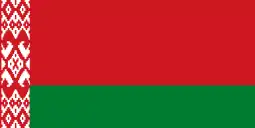 Belarus: Analogue broadcasting was disabled 15 May 2015 in the UHF band and 16 June 2015 in the VHF band (channels 6-12). The final analogue switch-off occurred at 4 January 2016.
Belarus: Analogue broadcasting was disabled 15 May 2015 in the UHF band and 16 June 2015 in the VHF band (channels 6-12). The final analogue switch-off occurred at 4 January 2016..svg.png.webp) Belgium: Media regulations are under regional legislation. Flanders switched off analog television on Monday 3 November 2008, while in Wallonia, all analog services were switched off on Monday, 1 March 2010, making the country completely serviced by digital signal. However, analog cable is still used by many cable subscribers, so therefore a cable switchover is unlikely to happen in the near future.
Belgium: Media regulations are under regional legislation. Flanders switched off analog television on Monday 3 November 2008, while in Wallonia, all analog services were switched off on Monday, 1 March 2010, making the country completely serviced by digital signal. However, analog cable is still used by many cable subscribers, so therefore a cable switchover is unlikely to happen in the near future. Bulgaria: Bulgaria launched a free-to-air platform in the Sofia region, starting in November 2004. The Communications Regulatory Commission (CRC) has said that it received 6 bids for the licence to build and operate Bulgaria's two nationwide DTT networks. A second licence tender for the operation of 3 DTT multiplexes was open until 27 May 2009.[104][105] Following the closing of this process, Hannu Pro, part of Silicon Group, and with Baltic Operations has secured the license to operate three DTT multiplexes in Bulgaria by the country's Communications Regulatory Commission (CRC) Bulgaria completed the transition to digital broadcasting in September 2013.[106][107]
Bulgaria: Bulgaria launched a free-to-air platform in the Sofia region, starting in November 2004. The Communications Regulatory Commission (CRC) has said that it received 6 bids for the licence to build and operate Bulgaria's two nationwide DTT networks. A second licence tender for the operation of 3 DTT multiplexes was open until 27 May 2009.[104][105] Following the closing of this process, Hannu Pro, part of Silicon Group, and with Baltic Operations has secured the license to operate three DTT multiplexes in Bulgaria by the country's Communications Regulatory Commission (CRC) Bulgaria completed the transition to digital broadcasting in September 2013.[106][107]
 Croatia: Analog television broadcasts were switched off for all national TV channels on Tuesday 5 October 2010 at 12:35 and for local TV channels on Saturday 20 November 2010.[108]
Croatia: Analog television broadcasts were switched off for all national TV channels on Tuesday 5 October 2010 at 12:35 and for local TV channels on Saturday 20 November 2010.[108] Cyprus terminated all analog transmissions on Thursday 30 June 2011 and moved to digital-only transmissions in MPEG-4 on Friday 1 July 2011.
Cyprus terminated all analog transmissions on Thursday 30 June 2011 and moved to digital-only transmissions in MPEG-4 on Friday 1 July 2011.
 Czech Republic: The last analog retransmitters in the south-east Moravia and the northern Moravia - Silesia were switched off on Saturday, 30 June 2012.
Czech Republic: The last analog retransmitters in the south-east Moravia and the northern Moravia - Silesia were switched off on Saturday, 30 June 2012. Denmark switched off all terrestrial analog services at midnight on Sunday 1 November 2009.[109] Analogue cable was switched off on 9 February 2016.[110] Analogue satellite were terminated by 2006 when DR 2 and TV3 ended their analogue signals on the Intelsat 10-02/Thor satellite at 0.8°W.[111] DR 2 was the last ever broadcast using the D2-MAC standard when it closed on 1 July.
Denmark switched off all terrestrial analog services at midnight on Sunday 1 November 2009.[109] Analogue cable was switched off on 9 February 2016.[110] Analogue satellite were terminated by 2006 when DR 2 and TV3 ended their analogue signals on the Intelsat 10-02/Thor satellite at 0.8°W.[111] DR 2 was the last ever broadcast using the D2-MAC standard when it closed on 1 July.
 Greenland launched digital services in Nuuk in August 2002.[112] The last settlement that upgraded to digital was Siorapaluk in 2012, with analogue switched off in October.[113]
Greenland launched digital services in Nuuk in August 2002.[112] The last settlement that upgraded to digital was Siorapaluk in 2012, with analogue switched off in October.[113] Faroe Islands launched DTT in December 2002. Most of the analogue signals were switched off immediately.[114]
Faroe Islands launched DTT in December 2002. Most of the analogue signals were switched off immediately.[114]
 Estonia's analog television was switched off completely on Thursday, 1 July 2010.
Estonia's analog television was switched off completely on Thursday, 1 July 2010.

 Finland ceased analog terrestrial transmissions nationwide at 04:00, Saturday, 1 September 2007[115] (the switch-off was previously planned for midnight but a few extra hours were added for technical reasons). This was controversial, as the cost of a digital TV set in Finland at the time was heavily criticised and saw a substantial decrease in how much the television license cost. Cable TV viewers continued to receive analog broadcasts until the end of February 2008.
Finland ceased analog terrestrial transmissions nationwide at 04:00, Saturday, 1 September 2007[115] (the switch-off was previously planned for midnight but a few extra hours were added for technical reasons). This was controversial, as the cost of a digital TV set in Finland at the time was heavily criticised and saw a substantial decrease in how much the television license cost. Cable TV viewers continued to receive analog broadcasts until the end of February 2008. France switched off all analog services (terrestrial, satellite and cable) on Tuesday, 29 November 2011. This included overseas departments and territories such as Guadeloupe, French Guiana, Martinique, Mayotte, Réunion, French Polynesia, New Caledonia, Saint Barthelemy, Saint Martin, Saint Pierre and Miquelon, and Wallis and Futuna.
France switched off all analog services (terrestrial, satellite and cable) on Tuesday, 29 November 2011. This included overseas departments and territories such as Guadeloupe, French Guiana, Martinique, Mayotte, Réunion, French Polynesia, New Caledonia, Saint Barthelemy, Saint Martin, Saint Pierre and Miquelon, and Wallis and Futuna. Germany started the switch-off in the Berlin area, beginning on Friday, 1 November 2002 and completing on Monday 4 August 2003 becoming the first city to do so. "Simulcast" digital transmissions started in other parts of the country in an effort to prepare for a full switchover. The switch-off of terrestrial analog transmitters was completed on Tuesday 25 November 2007, except one main transmitter in Bad Mergentheim, which was shut down in June 2009. Analog satellite receivers were still used by 6% of households in 2010 - the highest in Europe. The analog satellite transmissions (broadcasting on Astra 19.2°E) were switched off on Monday 30 April 2012, being the last in Europe. However, analog cable is still used by about 30% of the population and 55% of all cable broadcasts. The cable TV provider Unitymedia switched off analog cable on 27 June 2017.[116]
Germany started the switch-off in the Berlin area, beginning on Friday, 1 November 2002 and completing on Monday 4 August 2003 becoming the first city to do so. "Simulcast" digital transmissions started in other parts of the country in an effort to prepare for a full switchover. The switch-off of terrestrial analog transmitters was completed on Tuesday 25 November 2007, except one main transmitter in Bad Mergentheim, which was shut down in June 2009. Analog satellite receivers were still used by 6% of households in 2010 - the highest in Europe. The analog satellite transmissions (broadcasting on Astra 19.2°E) were switched off on Monday 30 April 2012, being the last in Europe. However, analog cable is still used by about 30% of the population and 55% of all cable broadcasts. The cable TV provider Unitymedia switched off analog cable on 27 June 2017.[116] Georgia: Analog broadcasts should have been switched off 17 June 2015, but due to the flooding in Tbilisi, which occurred on the night of 13 to 14 June 2015 analogue switch-off happened on 1 July 2015.[117]
Georgia: Analog broadcasts should have been switched off 17 June 2015, but due to the flooding in Tbilisi, which occurred on the night of 13 to 14 June 2015 analogue switch-off happened on 1 July 2015.[117] Greece: Digital broadcasting of privately owned nationwide TV channels began by Digea in Greece on 24 September 2009, covering a large section of the Corinthian gulf in northern Peloponnese. During the 2009-2013 transition period, a total of 13 digital broadcasting centers were activated throughout Greece, covering approximately 70% of the Greek population.[118] Analog terrestrial transmissions were first terminated at the Peloponnese region on 27 June 2014. Five more switch-offs followed in 2014 and the analog shutdown was completed on Friday, 6 February 2015.[119][120][121] Α total of 156 broadcasting centres are currently active throughout the country, covering over 96% of the country's population.[122]
Greece: Digital broadcasting of privately owned nationwide TV channels began by Digea in Greece on 24 September 2009, covering a large section of the Corinthian gulf in northern Peloponnese. During the 2009-2013 transition period, a total of 13 digital broadcasting centers were activated throughout Greece, covering approximately 70% of the Greek population.[118] Analog terrestrial transmissions were first terminated at the Peloponnese region on 27 June 2014. Five more switch-offs followed in 2014 and the analog shutdown was completed on Friday, 6 February 2015.[119][120][121] Α total of 156 broadcasting centres are currently active throughout the country, covering over 96% of the country's population.[122] Hungary: Hungarian analog terrestrial transmissions stopped on Thursday, 31 October 2013, after completing two phases that ended on 31 July and 31 October, respectively.
Hungary: Hungarian analog terrestrial transmissions stopped on Thursday, 31 October 2013, after completing two phases that ended on 31 July and 31 October, respectively. Iceland: All analog terrestrial transmissions were switched off on Monday, 2 February 2015.[123][124][125]
Iceland: All analog terrestrial transmissions were switched off on Monday, 2 February 2015.[123][124][125] Ireland: Digital terrestrial television was launched in Ireland as Saorview on Friday 29 October 2010.[126] At launch it had 5 standard-definition channels and 1 high-definition channel. The analog service was terminated on Wednesday 24 October 2012[127] and was replaced by a second multiplex for Saorview. A small number of low power independent analog re-broadcast systems remained licensed until the Monday 31 December 2012.[128] Analogue cable was shut down on 8 April 2019. Analogue satellite from Astra 28.2°E was discontinued on Thursday 27 September 2001.
Ireland: Digital terrestrial television was launched in Ireland as Saorview on Friday 29 October 2010.[126] At launch it had 5 standard-definition channels and 1 high-definition channel. The analog service was terminated on Wednesday 24 October 2012[127] and was replaced by a second multiplex for Saorview. A small number of low power independent analog re-broadcast systems remained licensed until the Monday 31 December 2012.[128] Analogue cable was shut down on 8 April 2019. Analogue satellite from Astra 28.2°E was discontinued on Thursday 27 September 2001. Italy: The conversion to digital television progressed region–by–region. It started in Sardinia on Wednesday 15 October 2008, and was completed on Wednesday 4 July 2012, when the last analog transmitters in the Province of Palermo were shut down. The switchover was politically controversial due to a 2004 law that seemed to favor Mediaset, owned by the Prime Minister Silvio Berlusconi, in the television market. A 2006 bill proposed by Paolo Gentiloni passed the government of Romano Prodi that would make one of Mediaset's channels as well as one from public broadcaster RAI move to digital three years before the switch. The bill was called "tailored for political revenge" by Berlusconi.[129] In 2011 the European Court of Justice ruled that the digital switchover in Italy was illegally subsidised favoring Berlusconi's media group.[130] Analogue satellite broadcasts were switched off from the Hot Bird 13°E satellite on 29 April 2005 by RAI.[131][132]
Italy: The conversion to digital television progressed region–by–region. It started in Sardinia on Wednesday 15 October 2008, and was completed on Wednesday 4 July 2012, when the last analog transmitters in the Province of Palermo were shut down. The switchover was politically controversial due to a 2004 law that seemed to favor Mediaset, owned by the Prime Minister Silvio Berlusconi, in the television market. A 2006 bill proposed by Paolo Gentiloni passed the government of Romano Prodi that would make one of Mediaset's channels as well as one from public broadcaster RAI move to digital three years before the switch. The bill was called "tailored for political revenge" by Berlusconi.[129] In 2011 the European Court of Justice ruled that the digital switchover in Italy was illegally subsidised favoring Berlusconi's media group.[130] Analogue satellite broadcasts were switched off from the Hot Bird 13°E satellite on 29 April 2005 by RAI.[131][132] Latvia's analog television completely converted to digital broadcasting on Tuesday 1 June 2010.
Latvia's analog television completely converted to digital broadcasting on Tuesday 1 June 2010. Lithuania: The switch-off of the analog terrestrial transmissions was completed on Monday, 29 October 2012.
Lithuania: The switch-off of the analog terrestrial transmissions was completed on Monday, 29 October 2012. Luxembourg shut down their last analog transmitter on UHF Channel 21 on Friday 31 December 2010.
Luxembourg shut down their last analog transmitter on UHF Channel 21 on Friday 31 December 2010. Moldova: Launched its first DTT service in November 2016. Analog broadcasts were discontinued from 1 March 2020. The process was somewhat difficult due to the high costs of upgrading to digital.[133]
Moldova: Launched its first DTT service in November 2016. Analog broadcasts were discontinued from 1 March 2020. The process was somewhat difficult due to the high costs of upgrading to digital.[133]
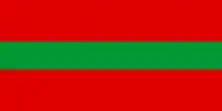 Transnistria DTT based on DVB-T started broadcasting on 30 December 2012 but only in testing phase until 2015.[134] The DVB-T2 public rollout commenced in April 2016.[135] Analog broadcasts for Transnistria shut down in the period 2018–2019.[136]
Transnistria DTT based on DVB-T started broadcasting on 30 December 2012 but only in testing phase until 2015.[134] The DVB-T2 public rollout commenced in April 2016.[135] Analog broadcasts for Transnistria shut down in the period 2018–2019.[136]
 North Macedonia: Analog transmissions were terminated on Saturday, 1 June 2013.[137]
North Macedonia: Analog transmissions were terminated on Saturday, 1 June 2013.[137] Northern Cyprus: Broadcaster BRT halted analog signals on 31 March 2019, replaced by DVB-T which started testing in the country in 2009.[138]
Northern Cyprus: Broadcaster BRT halted analog signals on 31 March 2019, replaced by DVB-T which started testing in the country in 2009.[138] Malta terminated all analog services on Monday, 31 October 2011. The switch-off was originally planned for Wednesday 1 June 2011 but was delayed for unknown reasons.[139]
Malta terminated all analog services on Monday, 31 October 2011. The switch-off was originally planned for Wednesday 1 June 2011 but was delayed for unknown reasons.[139] Monaco switched off their analog TV broadcasts on Tuesday 24 May 2011.
Monaco switched off their analog TV broadcasts on Tuesday 24 May 2011. Montenegro: Has shut down analog signals on 17 June 2015.[140]
Montenegro: Has shut down analog signals on 17 June 2015.[140] Netherlands moved to digital-only terrestrial broadcasting on Monday, 11 December 2006, being the second country to do so. The switch-off was noticed by few, since the overwhelming majority receive TV via cable and only around 74,000 households relied on terrestrial over-the-air broadcasts.[2] The switch-off was helped greatly as cable continued to use analog distribution, and thus consumers' old tuners continued to be useful. In March 2018, major cable provider Ziggo has announced that it will gradually phase out analogue cable TV transmissions in the next two years.[141] Analogue satellite transmissions from Astra 19.2°E were halted on 18 August 1996, just two months after digital was introduced. This was felt by few people, however, due to low satellite usage.[142]
Netherlands moved to digital-only terrestrial broadcasting on Monday, 11 December 2006, being the second country to do so. The switch-off was noticed by few, since the overwhelming majority receive TV via cable and only around 74,000 households relied on terrestrial over-the-air broadcasts.[2] The switch-off was helped greatly as cable continued to use analog distribution, and thus consumers' old tuners continued to be useful. In March 2018, major cable provider Ziggo has announced that it will gradually phase out analogue cable TV transmissions in the next two years.[141] Analogue satellite transmissions from Astra 19.2°E were halted on 18 August 1996, just two months after digital was introduced. This was felt by few people, however, due to low satellite usage.[142] Norway: The switch-off of the analog transmissions started in March 2008 and was completed on Tuesday 1 December 2009. Norway started its DTT service on the Saturday 1 September 2007.[143] Analog satellite broadcasts of NRK and TV 2 on the Thor 4.3°W satellite ended on 15 October 2002.[144]
Norway: The switch-off of the analog transmissions started in March 2008 and was completed on Tuesday 1 December 2009. Norway started its DTT service on the Saturday 1 September 2007.[143] Analog satellite broadcasts of NRK and TV 2 on the Thor 4.3°W satellite ended on 15 October 2002.[144] Poland: Terrestrial television in Poland is broadcast using a digital DVB-T system. First test DVB-T emission was carried in Warsaw at 9 November 2001. In April 2004, first DVB-T transmitter near Rzeszów started operation, and local TVP division started to market set-top boxes allowing to receive it. The shutdown of analog broadcasts took place in 7 steps from 7 November 2012 to 23 July 2013 when analog terrestrial transmissions were completely terminated. Analog broadcasts on satellite ended when TVN stopped its analog transmission on the Hot Bird 13°E satellite in 2008.
Poland: Terrestrial television in Poland is broadcast using a digital DVB-T system. First test DVB-T emission was carried in Warsaw at 9 November 2001. In April 2004, first DVB-T transmitter near Rzeszów started operation, and local TVP division started to market set-top boxes allowing to receive it. The shutdown of analog broadcasts took place in 7 steps from 7 November 2012 to 23 July 2013 when analog terrestrial transmissions were completely terminated. Analog broadcasts on satellite ended when TVN stopped its analog transmission on the Hot Bird 13°E satellite in 2008.  Portugal: Digital terrestrial broadcasts started on Wednesday 29 April 2009. Portugal's government hoped to cover 80% of the territory with digital terrestrial TV by the end of 2009, and simulcasts remained until Thursday 26 April 2012, when the analog broadcasting ended. This switchover began on Thursday 12 January 2012. Analog cable is still available from all pay-TV providers (including fiber), for homes with multiple televisions. There are no plans in place to switch-off analog cable. The digital versions of all channels have traditionally been encrypted and could only be accessed with a proprietary set-top-box, which subscribers had to pay for with a monthly fee. Starting in October 2017, cable provider NOS unencrypted the digital versions of its base channels, enabling them to be tuned directly by televisions with support for MPEG-4 (or digital terrestrial) or any freely available digital tuner.[145] Channels belonging to subscription packs, as well as premium channels, still require a proprietary set top box to be viewed. Other pay-TV providers - Vodafone, NOWO and Meo - similarly no longer encrypt the digital versions of their base channels.
Portugal: Digital terrestrial broadcasts started on Wednesday 29 April 2009. Portugal's government hoped to cover 80% of the territory with digital terrestrial TV by the end of 2009, and simulcasts remained until Thursday 26 April 2012, when the analog broadcasting ended. This switchover began on Thursday 12 January 2012. Analog cable is still available from all pay-TV providers (including fiber), for homes with multiple televisions. There are no plans in place to switch-off analog cable. The digital versions of all channels have traditionally been encrypted and could only be accessed with a proprietary set-top-box, which subscribers had to pay for with a monthly fee. Starting in October 2017, cable provider NOS unencrypted the digital versions of its base channels, enabling them to be tuned directly by televisions with support for MPEG-4 (or digital terrestrial) or any freely available digital tuner.[145] Channels belonging to subscription packs, as well as premium channels, still require a proprietary set top box to be viewed. Other pay-TV providers - Vodafone, NOWO and Meo - similarly no longer encrypt the digital versions of their base channels. Romania has one of the highest pay-TV penetration rates in Europe, with over 98% of homes receiving cable or satellite TV services. Also over 90% of population is covered with DVB-T2 digital terrestrial television signal. The last analog transmitters were switched off on 1 May 2018 when TVR decided to order the shut down due to low demand and high operating costs.[146]
Romania has one of the highest pay-TV penetration rates in Europe, with over 98% of homes receiving cable or satellite TV services. Also over 90% of population is covered with DVB-T2 digital terrestrial television signal. The last analog transmitters were switched off on 1 May 2018 when TVR decided to order the shut down due to low demand and high operating costs.[146] Russia: On 22 December 2018, Russia completed the creation of the world's largest digital television broadcasting system, with 10,080 transmitters operating at 5,040 sites throughout the country. On 3 December 2018, analog transmissions were switched off in the Tver Region including the city of Tver. Analog transmissions in Ryazan, Tula, Yaroslavl, Ulyanovsk, Penza, Magadan, and Chechnya ended on 11 February 2019, while those in 20 other regions which includes Moscow and the Moscow Region were switched off on 15 April 2019. On 3 June 2019, analog transmissions in 36 regions were discontinued which include the oblasts of Vladimir, Samara, Nizhny Novgorod, Krasnoyarsk and Oryol. Switchover in the last 21 regions has completed on 14 October 2019. The regions include St. Petersburg, the Leningrad Region, the Republic of Crimea and Sevastopol. Channels that are not offered as multiplex services (i.e. federal and regional channels) are still broadcast in analog.[147]
Russia: On 22 December 2018, Russia completed the creation of the world's largest digital television broadcasting system, with 10,080 transmitters operating at 5,040 sites throughout the country. On 3 December 2018, analog transmissions were switched off in the Tver Region including the city of Tver. Analog transmissions in Ryazan, Tula, Yaroslavl, Ulyanovsk, Penza, Magadan, and Chechnya ended on 11 February 2019, while those in 20 other regions which includes Moscow and the Moscow Region were switched off on 15 April 2019. On 3 June 2019, analog transmissions in 36 regions were discontinued which include the oblasts of Vladimir, Samara, Nizhny Novgorod, Krasnoyarsk and Oryol. Switchover in the last 21 regions has completed on 14 October 2019. The regions include St. Petersburg, the Leningrad Region, the Republic of Crimea and Sevastopol. Channels that are not offered as multiplex services (i.e. federal and regional channels) are still broadcast in analog.[147]
 San Marino completed its switch-off on Thursday 2 December 2010.
San Marino completed its switch-off on Thursday 2 December 2010. Serbia launched its first DTT transmissions in 2005. The first DTT-only channel was made available in 2008. As of 2013, the DVB-T2 network covers Belgrade and much of Vojvodina, several cities in Šumadija and Western Serbia and the southern city of Niš.[148] Digital TV switchover for 98% of citizens started on 1 September 2014. Transition progressed in six stages. First switchoff took place in Vršac on 15 April 2015.[149] Last switchoff took place on 7 June 2015.
Serbia launched its first DTT transmissions in 2005. The first DTT-only channel was made available in 2008. As of 2013, the DVB-T2 network covers Belgrade and much of Vojvodina, several cities in Šumadija and Western Serbia and the southern city of Niš.[148] Digital TV switchover for 98% of citizens started on 1 September 2014. Transition progressed in six stages. First switchoff took place in Vršac on 15 April 2015.[149] Last switchoff took place on 7 June 2015. Slovakia: Slovakia finished analog transmission broadcasts on Monday, 31 December 2012.
Slovakia: Slovakia finished analog transmission broadcasts on Monday, 31 December 2012. Slovenia: The switch-off of main transmitters was completed on Wednesday 1 December 2010. The last local analog transmitters were switched off on Thursday 30 June 2011.
Slovenia: The switch-off of main transmitters was completed on Wednesday 1 December 2010. The last local analog transmitters were switched off on Thursday 30 June 2011.

 Spain: The switch-off of the analog terrestrial transmissions was completed on Saturday 3 April 2010. The switch-off was successful, as about 70% of Spanish television transmissions are terrestrial, so it was easy for people to just switch to the digital signal. Spain started its DTT service on Wednesday 30 November 2005.[150]
Spain: The switch-off of the analog terrestrial transmissions was completed on Saturday 3 April 2010. The switch-off was successful, as about 70% of Spanish television transmissions are terrestrial, so it was easy for people to just switch to the digital signal. Spain started its DTT service on Wednesday 30 November 2005.[150] Sweden: The switch-off of the analog terrestrial network progressed region–by–region. It started on the island of Gotland on Monday, 19 September 2005, and was completed on Monday 15 October 2007, when the last analog SVT1 transmitters in Blekinge and western Scania were shut down.[151] Cable broadcasters continue to broadcast in analog. Analog broadcasts from the Sirius and Thor satellites were ended by April 2004.[152]
Sweden: The switch-off of the analog terrestrial network progressed region–by–region. It started on the island of Gotland on Monday, 19 September 2005, and was completed on Monday 15 October 2007, when the last analog SVT1 transmitters in Blekinge and western Scania were shut down.[151] Cable broadcasters continue to broadcast in analog. Analog broadcasts from the Sirius and Thor satellites were ended by April 2004.[152] Switzerland (including
Switzerland (including  Liechtenstein) began with the switch-off on Monday 24 July 2006 in Ticino and continued with Engadin on Monday 13 November 2006. The switch-off was completed on Monday 26 November 2007. A very high percentage of Swiss viewers receive their signals via cable distributors. By 2012 40% of cable viewers had switched to digital. Analog cable was switched off on 1 January 2017.[153] The country switched off its terrestrial network entirely in 2019 due to low penetration.[154]
Liechtenstein) began with the switch-off on Monday 24 July 2006 in Ticino and continued with Engadin on Monday 13 November 2006. The switch-off was completed on Monday 26 November 2007. A very high percentage of Swiss viewers receive their signals via cable distributors. By 2012 40% of cable viewers had switched to digital. Analog cable was switched off on 1 January 2017.[153] The country switched off its terrestrial network entirely in 2019 due to low penetration.[154] United Kingdom: Digital terrestrial broadcasting began in the UK on Sunday 15 November 1998 with the launch of the ONdigital, later renamed ITV Digital and now Freeview. The transition from analogue and digital to digital-only terrestrial signals started on Wednesday 17 October 2007 with the Whitehaven transmitter in Cumberland,[155] and followed a transmitter switchover timetable, implemented by region. The first constituent country to switch off all its analogue signals was Wales on Wednesday 31 March 2010[156] and the last region to switch off its analogue signals was Northern Ireland on Wednesday 24 October 2012.[157] Analogue cable broadcasts eventually ended and fully ceased, on 28 November 2013, when Milton Keynes finally saw their service terminate, after a settling of a cable ownership dispute between BT Group and Virgin Media. Analogue satellite (from the Astra 28.2°E satellite) was discontinued on Thursday 27 September 2001. Analogue transmissions ceased in
United Kingdom: Digital terrestrial broadcasting began in the UK on Sunday 15 November 1998 with the launch of the ONdigital, later renamed ITV Digital and now Freeview. The transition from analogue and digital to digital-only terrestrial signals started on Wednesday 17 October 2007 with the Whitehaven transmitter in Cumberland,[155] and followed a transmitter switchover timetable, implemented by region. The first constituent country to switch off all its analogue signals was Wales on Wednesday 31 March 2010[156] and the last region to switch off its analogue signals was Northern Ireland on Wednesday 24 October 2012.[157] Analogue cable broadcasts eventually ended and fully ceased, on 28 November 2013, when Milton Keynes finally saw their service terminate, after a settling of a cable ownership dispute between BT Group and Virgin Media. Analogue satellite (from the Astra 28.2°E satellite) was discontinued on Thursday 27 September 2001. Analogue transmissions ceased in  Gibraltar in December 2012 (replaced by DVB-T Gibraltar Freeview),[158]
Gibraltar in December 2012 (replaced by DVB-T Gibraltar Freeview),[158]  Isle of Man switched off all analogue services on Thursday 16 July 2009,[159] while
Isle of Man switched off all analogue services on Thursday 16 July 2009,[159] while  Jersey and
Jersey and  Guernsey switched off their analogue signals on Wednesday 17 November 2010. Sales of analog TV sets stopped on July 6 2010.[160]
Guernsey switched off their analogue signals on Wednesday 17 November 2010. Sales of analog TV sets stopped on July 6 2010.[160]
 Vatican City: Digital transition completed in 2012.[161]
Vatican City: Digital transition completed in 2012.[161]
Oceania
 American Samoa Complied with the FCC transition to ATSC digital on 12 June 2009 on all full-power stations.
American Samoa Complied with the FCC transition to ATSC digital on 12 June 2009 on all full-power stations..svg.png.webp) Australia: Digital television commenced in Australia's five most populous cities on Monday 1 January 2001. The Mildura region was the first to terminate its analog network, on Wednesday 30 June 2010. Digital switchover was originally expected to be complete by Tuesday 31 December 2013, however, the last regions to switch over (Melbourne and Remote Eastern/Central Australia) did so slightly earlier, on Tuesday 10 December 2013 at 9:00 am.[162] Until the switch-off in the respective areas, free-to-air stations were simulcast, along with digital-only channels like ABC2. Cable television networks began simulcasting in 2004 and analog cable services were switched off in April 2007. The switchover was co-ordinated by the Digital Switchover Taskforce operating under the federal Department of Broadband, Communications and the Digital Economy.
Australia: Digital television commenced in Australia's five most populous cities on Monday 1 January 2001. The Mildura region was the first to terminate its analog network, on Wednesday 30 June 2010. Digital switchover was originally expected to be complete by Tuesday 31 December 2013, however, the last regions to switch over (Melbourne and Remote Eastern/Central Australia) did so slightly earlier, on Tuesday 10 December 2013 at 9:00 am.[162] Until the switch-off in the respective areas, free-to-air stations were simulcast, along with digital-only channels like ABC2. Cable television networks began simulcasting in 2004 and analog cable services were switched off in April 2007. The switchover was co-ordinated by the Digital Switchover Taskforce operating under the federal Department of Broadband, Communications and the Digital Economy. Guam: Complied with the FCC transition to digital on 12 June 2009 on all full-power stations.[163]
Guam: Complied with the FCC transition to digital on 12 June 2009 on all full-power stations.[163] Micronesia: FSMTC (FSM Telecommunications Company) provides a subscription based digital over the air (DVB-T) service to Kosrae, Chuuk and Yap. This provides various international television channels and a local information channel. No local television broadcasters operate in FSM.
Micronesia: FSMTC (FSM Telecommunications Company) provides a subscription based digital over the air (DVB-T) service to Kosrae, Chuuk and Yap. This provides various international television channels and a local information channel. No local television broadcasters operate in FSM. Northern Mariana Islands Complied with the FCC transition to ATSC digital on 12 June 2009 on all full-power stations.
Northern Mariana Islands Complied with the FCC transition to ATSC digital on 12 June 2009 on all full-power stations. New Zealand: Digital terrestrial television broadcasts began officially in April 2008. analog PAL switchoff started on 30 September 2012 with the North Island's Hawke's Bay region and the South Island's West Coast region and finished with the Upper North Island which was switched off 1 December 2013.[164]
New Zealand: Digital terrestrial television broadcasts began officially in April 2008. analog PAL switchoff started on 30 September 2012 with the North Island's Hawke's Bay region and the South Island's West Coast region and finished with the Upper North Island which was switched off 1 December 2013.[164]
Transitions in progress
Africa
 Angola Trials using the ISDB-T standard were tested in 2011. Later in 2013 the state decided to use DVB-T2 instead, with a launch date for 2017.[165] However this was reviewed once again and in 2019 Angola picked ISDB-T to be the standard for its future DTT network.[166] The process began in 2020 with the aim of being complete by 2025–28.[167]
Angola Trials using the ISDB-T standard were tested in 2011. Later in 2013 the state decided to use DVB-T2 instead, with a launch date for 2017.[165] However this was reviewed once again and in 2019 Angola picked ISDB-T to be the standard for its future DTT network.[166] The process began in 2020 with the aim of being complete by 2025–28.[167] Botswana began digital broadcasts in 2008, using ISDB-T. Analogue is set to be terminated in 2024.[168]
Botswana began digital broadcasts in 2008, using ISDB-T. Analogue is set to be terminated in 2024.[168]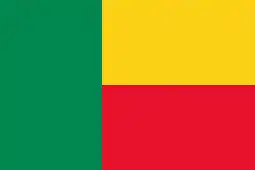 Benin is in transition to digital as of 2018. No completion date yet.[33]
Benin is in transition to digital as of 2018. No completion date yet.[33] Burkina Faso is in transition to digital as of 2018. No completion date yet.[33]
Burkina Faso is in transition to digital as of 2018. No completion date yet.[33] Burundi DTT broadcasts launched on 30 April 2014 and it was expected to shut analog down at the end of that year.[169] However the transition was not easy and analog remained on air, still as of 2019. No completion date yet.[170]
Burundi DTT broadcasts launched on 30 April 2014 and it was expected to shut analog down at the end of that year.[169] However the transition was not easy and analog remained on air, still as of 2019. No completion date yet.[170] Cameroon is transitioning as of 2015. No completion date yet.[171]
Cameroon is transitioning as of 2015. No completion date yet.[171]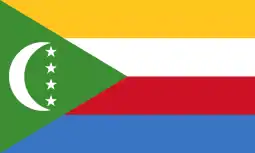 Comoros has introduced digital broadcasts using the DTMB standard. No completion date yet.[172]
Comoros has introduced digital broadcasts using the DTMB standard. No completion date yet.[172]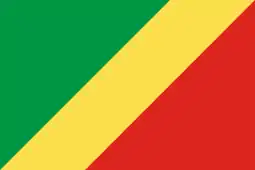 Republic of the Congo: DTT started trials in December 2016.[173] It was announced in June 2018 that DTT should start in 2019. No completion date yet.[174]
Republic of the Congo: DTT started trials in December 2016.[173] It was announced in June 2018 that DTT should start in 2019. No completion date yet.[174] Democratic Republic of the Congo is in transition to digital as of 2014. No completion date yet.[175]
Democratic Republic of the Congo is in transition to digital as of 2014. No completion date yet.[175] Egypt has had DVB-T transmissions for several years as of 2019, with plans to roll out DVB-T2 that year. There is no analog switchoff date yet.[176]
Egypt has had DVB-T transmissions for several years as of 2019, with plans to roll out DVB-T2 that year. There is no analog switchoff date yet.[176] Ethiopia in 2016 begun its digital switch-over to DVB-T2 with help from American digital transmitter manufacturer GatesAir and funded by JPMorgan Chase and Export Development Canada. According to the government this might finish between 2021 and 2026.[177]
Ethiopia in 2016 begun its digital switch-over to DVB-T2 with help from American digital transmitter manufacturer GatesAir and funded by JPMorgan Chase and Export Development Canada. According to the government this might finish between 2021 and 2026.[177] The Gambia is in transition and aiming to complete analog switch off by 2020.[178]
The Gambia is in transition and aiming to complete analog switch off by 2020.[178] Madagascar: Introduced DTT based on DVB-T in 2014. No completion date yet.[179]
Madagascar: Introduced DTT based on DVB-T in 2014. No completion date yet.[179] Mali: The country's regulator authorized TNTSAT Africa to start the transition to digital in 2018. No completion date yet.[180]
Mali: The country's regulator authorized TNTSAT Africa to start the transition to digital in 2018. No completion date yet.[180] Morocco: DTT launched in March 2007.[181] Analogue transmitters on UHF band were switched off on 17 June 2015.[182] Only Al Aoula will stay on analog signal.[183] Analogue channels in the VHF band switched off on 17 June 2020.[184]
Morocco: DTT launched in March 2007.[181] Analogue transmitters on UHF band were switched off on 17 June 2015.[182] Only Al Aoula will stay on analog signal.[183] Analogue channels in the VHF band switched off on 17 June 2020.[184]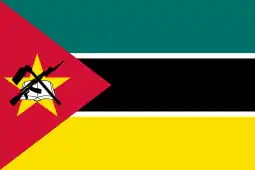 Mozambique began transitioning to DVB-T2 in 2013.[185] Official launch 8 December 2015. No completion date yet.[186]
Mozambique began transitioning to DVB-T2 in 2013.[185] Official launch 8 December 2015. No completion date yet.[186] Niger: DTT was deployed on 21 September 2018 after 3 years testing.[187][188] No ASO date yet.
Niger: DTT was deployed on 21 September 2018 after 3 years testing.[187][188] No ASO date yet. Nigeria's switchover to DVB-T2 is ongoing stewarded by GatesAir. The aim is to complete the switchover by December 2021.[189][190]
Nigeria's switchover to DVB-T2 is ongoing stewarded by GatesAir. The aim is to complete the switchover by December 2021.[189][190] Saint Helena introduced DTT in 2012. No completion date yet.[191]
Saint Helena introduced DTT in 2012. No completion date yet.[191] Senegal Excaf Telecom won the public tender in 2014 to broadcast the country's DVB-T2 DTT network. The analog switch began in September 2019 and will continue till 2020.[192]
Senegal Excaf Telecom won the public tender in 2014 to broadcast the country's DVB-T2 DTT network. The analog switch began in September 2019 and will continue till 2020.[192] Seychelles is in transition to digital as of 2018. No completion date yet.[33]
Seychelles is in transition to digital as of 2018. No completion date yet.[33] Togo is in transition to digital as of 2018.[33] Broadcasting equipment manufacturer Harris Corporation is helping to transition Togo to DVB-T2. No completion date yet.[193]
Togo is in transition to digital as of 2018.[33] Broadcasting equipment manufacturer Harris Corporation is helping to transition Togo to DVB-T2. No completion date yet.[193] Tunisia began digital broadcasts in 2003, using DVB-T, then since 2015, using DVB-T2. Analog television will be turned off on 13 February 2021.
Tunisia began digital broadcasts in 2003, using DVB-T, then since 2015, using DVB-T2. Analog television will be turned off on 13 February 2021.
Americas
 Antigua and Barbuda: In Antigua there is digital television in some territories: Cades Bay, Johnsons Point, Orange Valley, Crab Hill, Urlings and Old Road. There is no date for completion.
Antigua and Barbuda: In Antigua there is digital television in some territories: Cades Bay, Johnsons Point, Orange Valley, Crab Hill, Urlings and Old Road. There is no date for completion. Argentina: Digital television broadcasts started on Tuesday, 9 September 2008 in Buenos Aires. The analog network was to be terminated on 1 January 2019, but it was further postponed until 2021.[21]
Argentina: Digital television broadcasts started on Tuesday, 9 September 2008 in Buenos Aires. The analog network was to be terminated on 1 January 2019, but it was further postponed until 2021.[21] Bahamas: The public broadcaster BCB transitioned to digital in September 2016. No completion date yet.[194]
Bahamas: The public broadcaster BCB transitioned to digital in September 2016. No completion date yet.[194] Bolivia: The President of the Authority for the Regulation and Control of Telecommunications and Transport (ATT), Roy Méndez, said that in November 2019, analogue switch-off took place in La Paz, El Alto, Cochabamba and Santa Cruz with no date for everywhere else nationwide.
Bolivia: The President of the Authority for the Regulation and Control of Telecommunications and Transport (ATT), Roy Méndez, said that in November 2019, analogue switch-off took place in La Paz, El Alto, Cochabamba and Santa Cruz with no date for everywhere else nationwide.

 Brazil: Began free-to-air HD digital transmissions, after a period of test broadcasts, on Sunday, 2 December 2007 in São Paulo, expanding in 2008 to Brasília, Rio de Janeiro, and Belo Horizonte.[195] Digital broadcasts were phased into the other 23 state capitals in the following years, and to the remaining cities by Tuesday 31 December 2013.[196] The country started on 1 March 2016 in Rio Verde, Goiás as a pilot experiment, followed by the Federal District and main cities and metropolitan regions from 17 November 2016 to 2020.[197] The transition was completed in most of the country on 9 January 2019; analog signals in the country's remaining rural areas are expected to switch off in 2023.
Brazil: Began free-to-air HD digital transmissions, after a period of test broadcasts, on Sunday, 2 December 2007 in São Paulo, expanding in 2008 to Brasília, Rio de Janeiro, and Belo Horizonte.[195] Digital broadcasts were phased into the other 23 state capitals in the following years, and to the remaining cities by Tuesday 31 December 2013.[196] The country started on 1 March 2016 in Rio Verde, Goiás as a pilot experiment, followed by the Federal District and main cities and metropolitan regions from 17 November 2016 to 2020.[197] The transition was completed in most of the country on 9 January 2019; analog signals in the country's remaining rural areas are expected to switch off in 2023..svg.png.webp) Canada: Canada's DTV transition was completed in 28 mandatory markets on Wednesday, 31 August 2011. Some CBC analog transmitters in mandatory markets were permitted to operate for another year, and transmitters outside mandatory markets were given the option of converting to digital, or remaining in analog. The CBC decided to shut down all (more than 600) of its remaining analog transmitters on Tuesday, 31 July 2012, without replacing them.[198] Also on 31 August 2011, all full-power TV transmitters had to vacate channels 52 to 69. There are a very small number of community-based transmitters broadcasting in analogue, which will be shut down no later than 2022;[199] see Digital television in Canada.
Canada: Canada's DTV transition was completed in 28 mandatory markets on Wednesday, 31 August 2011. Some CBC analog transmitters in mandatory markets were permitted to operate for another year, and transmitters outside mandatory markets were given the option of converting to digital, or remaining in analog. The CBC decided to shut down all (more than 600) of its remaining analog transmitters on Tuesday, 31 July 2012, without replacing them.[198] Also on 31 August 2011, all full-power TV transmitters had to vacate channels 52 to 69. There are a very small number of community-based transmitters broadcasting in analogue, which will be shut down no later than 2022;[199] see Digital television in Canada. Cayman Islands: Broadcaster Cayman 27 announced that it will start broadcasting digitally on ATSC in 2012. No completion date yet.[200]
Cayman Islands: Broadcaster Cayman 27 announced that it will start broadcasting digitally on ATSC in 2012. No completion date yet.[200] Chile: The transition to digital started in 2012. ASO has been delayed and is now set to be 2022.[201]
Chile: The transition to digital started in 2012. ASO has been delayed and is now set to be 2022.[201]
 Easter Island: Tenders started in July 2019. No completion date yet.[202]
Easter Island: Tenders started in July 2019. No completion date yet.[202]
 Colombia: Digital television broadcasts started on Monday, 20 September 2010. The government planned to close down analog broadcast on 31 December 2019, but it was postponed until 2021[20]
Colombia: Digital television broadcasts started on Monday, 20 September 2010. The government planned to close down analog broadcast on 31 December 2019, but it was postponed until 2021[20] Cuba began to propose DVB-T in May 2009. However, Cuba opted for the Chinese DTMB standard and began tests in 2013, with new digital transmitters being rolled out and a shutoff date in 2021.[203]
Cuba began to propose DVB-T in May 2009. However, Cuba opted for the Chinese DTMB standard and began tests in 2013, with new digital transmitters being rolled out and a shutoff date in 2021.[203] Curacao: Started DTT broadcasts based on DVB-T in 2009.[204] No date yet when to switch off the older NTSC analog broadcasts.[205]
Curacao: Started DTT broadcasts based on DVB-T in 2009.[204] No date yet when to switch off the older NTSC analog broadcasts.[205] Dominican Republic: The Dominican Government once set a final analog shut down date of all analog transmissions on 24 September 2015.[206] However, INDOTEL, a telecommunications department of the Dominican Government, postponed it to 9 August 2021.[19]
Dominican Republic: The Dominican Government once set a final analog shut down date of all analog transmissions on 24 September 2015.[206] However, INDOTEL, a telecommunications department of the Dominican Government, postponed it to 9 August 2021.[19] Ecuador: The analog switch off was delayed several times. In September 2018 the telecom ministry said that the first phase will start in May 2020 starting in Quito where it has finished and will continue until December 2023.[207]
Ecuador: The analog switch off was delayed several times. In September 2018 the telecom ministry said that the first phase will start in May 2020 starting in Quito where it has finished and will continue until December 2023.[207] El Salvador: Began on 21 December 2018, and it will be completed by 2022.[208]
El Salvador: Began on 21 December 2018, and it will be completed by 2022.[208] Jamaica: Deployed the ATSC standard for digital terrestrial TV and is aiming for an analog swich off by 2021.[209]
Jamaica: Deployed the ATSC standard for digital terrestrial TV and is aiming for an analog swich off by 2021.[209] Panama: Analog TV sets were no longer allowed be sold since the 11 June 2018, unless provided with a free DVB-T converter box. Since 11 December 2018, no analog TV sets may be sold, even if provided with a free converter box; This deadline was later extended until April 2019. The switchover date was on October 1 2020 for the provinces of Panamá, Colón, and Panamá Oeste. All other provinces have no switchover date. The switchover date has been delayed, having been originally planned for 2017. Due to COVID-19 pandemic remote learning measures the switchover date has been delayed again, this time until June 1, 2021.[210][211][212][213][214][215]
Panama: Analog TV sets were no longer allowed be sold since the 11 June 2018, unless provided with a free DVB-T converter box. Since 11 December 2018, no analog TV sets may be sold, even if provided with a free converter box; This deadline was later extended until April 2019. The switchover date was on October 1 2020 for the provinces of Panamá, Colón, and Panamá Oeste. All other provinces have no switchover date. The switchover date has been delayed, having been originally planned for 2017. Due to COVID-19 pandemic remote learning measures the switchover date has been delayed again, this time until June 1, 2021.[210][211][212][213][214][215] Paraguay: The transmission of digital television broadcasts started in August 2011, by TV Pública (which belongs to the Paraguayan government) with an initial coverage area of 25 kilometres (about 16 miles) from Asuncion downtown. The analog television system switch-off was taking place in 2020 however on 22 January 2019 La nacion reported the country pushed it back to 2021.[216]
Paraguay: The transmission of digital television broadcasts started in August 2011, by TV Pública (which belongs to the Paraguayan government) with an initial coverage area of 25 kilometres (about 16 miles) from Asuncion downtown. The analog television system switch-off was taking place in 2020 however on 22 January 2019 La nacion reported the country pushed it back to 2021.[216] Peru: Digital television broadcasts started in Lima and Callao (Territory 1) in March 2010, and analog broadcasts were terminated on 20 June 2020; Arequipa, Cusco, Trujillo, Piura and Huancayo (territory 2) started digital transition somewhere between April and June 2018 and analog broadcasts are scheduled to be terminated on 3 January 2023.
Peru: Digital television broadcasts started in Lima and Callao (Territory 1) in March 2010, and analog broadcasts were terminated on 20 June 2020; Arequipa, Cusco, Trujillo, Piura and Huancayo (territory 2) started digital transition somewhere between April and June 2018 and analog broadcasts are scheduled to be terminated on 3 January 2023. Sint Maarten: DVB-T adopted as at 2011,[217] and introduced by 2013. No completion date yet.[218]
Sint Maarten: DVB-T adopted as at 2011,[217] and introduced by 2013. No completion date yet.[218] Turks and Caicos Islands: People's Television Network (PTV) launched a digital service in 2010.[219] It uses the UHF band. No completion date yet.[220]
Turks and Caicos Islands: People's Television Network (PTV) launched a digital service in 2010.[219] It uses the UHF band. No completion date yet.[220] United States: A deadline for transition to digital broadcasting was set as 17 February 2009; this deadline was extended and performed instead on 12 June 2009. Exceptions to the 12 June deadline included low-power stations, and "nightlight" stations which broadcast PSAs on the transition until 12 July 2009. Class A low-power stations were then required to transition to digital by 1 September 2015. The low-power and translator station deadline was suspended on 24 April 2015, due to concerns that the then-upcoming 600 MHz spectrum auction could "potentially displace a significant number of LPTV and TV translator stations", and would "[require] analog stations to incur the costs of transitioning to digital before completion of the auction and repacking process".[221] After the auction's completion in 2017, the FCC announced 13 July 2021 as the new analog low-power shutoff date.[222]
United States: A deadline for transition to digital broadcasting was set as 17 February 2009; this deadline was extended and performed instead on 12 June 2009. Exceptions to the 12 June deadline included low-power stations, and "nightlight" stations which broadcast PSAs on the transition until 12 July 2009. Class A low-power stations were then required to transition to digital by 1 September 2015. The low-power and translator station deadline was suspended on 24 April 2015, due to concerns that the then-upcoming 600 MHz spectrum auction could "potentially displace a significant number of LPTV and TV translator stations", and would "[require] analog stations to incur the costs of transitioning to digital before completion of the auction and repacking process".[221] After the auction's completion in 2017, the FCC announced 13 July 2021 as the new analog low-power shutoff date.[222]
 Uruguay: Began broadcasting digital television in 2010. The analogue switch-off was planned for 21 November 2015, but was postponed indefinitely with no new switchover date yet.[223]
Uruguay: Began broadcasting digital television in 2010. The analogue switch-off was planned for 21 November 2015, but was postponed indefinitely with no new switchover date yet.[223]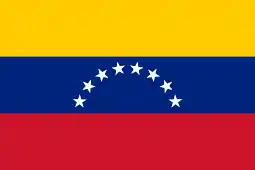 Venezuela: Digital television transmition began in 2007 for the broadcasting of 2007 Copa América. Later on 20 February 2013 transmissions began nationalwide. Analogue is set to be terminated in 2020[224]
Venezuela: Digital television transmition began in 2007 for the broadcasting of 2007 Copa América. Later on 20 February 2013 transmissions began nationalwide. Analogue is set to be terminated in 2020[224]
Asia
 Afghanistan: 4 channels of DVB-T2 were launched in Kabul in June 2014. ASO has however been repeatedly delayed. There is no date for the switchover.
Afghanistan: 4 channels of DVB-T2 were launched in Kabul in June 2014. ASO has however been repeatedly delayed. There is no date for the switchover. Bangladesh: Has adopted DVB-T and tested broadcasts as of 2014.[225] Public broadcaster BTV aims to make the country digital by 2021, its 50th anniversary of independence.[226]
Bangladesh: Has adopted DVB-T and tested broadcasts as of 2014.[225] Public broadcaster BTV aims to make the country digital by 2021, its 50th anniversary of independence.[226] Bhutan: Adopted DVB-T. The original analog switch off date was set to be 2017, although it did not occur.[225]
Bhutan: Adopted DVB-T. The original analog switch off date was set to be 2017, although it did not occur.[225] China: China started its transition to digital television in 2003, with cable and satellite television using DVB and terrestrial television using DTMB. Analog satellite television ended on March 31, 2006, after the last satellite television channels on Apstar-1A, including Zhejiang Television,[227] switched to digital, in which time the legal holders of satellite television receivers were limited to regional cable television providers, thus China never actually have the analog satellite television service provided to the masses. Analog cable television services are largely discontinued in the late 2000s and early 2010s. On May 14, 2016, all channels of China Central Television, the country's state broadcaster, converted to digital broadcasting in a 4-step conversion. Regional television broadcasters also began converting to digital. Analog terrestrial television is planned to be shut down nationalwide before March 31, 2021.[228] No deadline for cable television switchover was set, although a recent study shows that the coverage of digital cable television in all cable television users in China reaches 92% in Q1 2020, an all-time high.[229]
China: China started its transition to digital television in 2003, with cable and satellite television using DVB and terrestrial television using DTMB. Analog satellite television ended on March 31, 2006, after the last satellite television channels on Apstar-1A, including Zhejiang Television,[227] switched to digital, in which time the legal holders of satellite television receivers were limited to regional cable television providers, thus China never actually have the analog satellite television service provided to the masses. Analog cable television services are largely discontinued in the late 2000s and early 2010s. On May 14, 2016, all channels of China Central Television, the country's state broadcaster, converted to digital broadcasting in a 4-step conversion. Regional television broadcasters also began converting to digital. Analog terrestrial television is planned to be shut down nationalwide before March 31, 2021.[228] No deadline for cable television switchover was set, although a recent study shows that the coverage of digital cable television in all cable television users in China reaches 92% in Q1 2020, an all-time high.[229] India: Telecom Regulatory Authority of India has set the deadlines for the completion of Phase I (Metro cities) by 31 December 2019; which is already completed, Phase II (cities having a population of more than one million) by 31 December 2021, and Phase III (the rest of India) by 31 December 2023.
India: Telecom Regulatory Authority of India has set the deadlines for the completion of Phase I (Metro cities) by 31 December 2019; which is already completed, Phase II (cities having a population of more than one million) by 31 December 2021, and Phase III (the rest of India) by 31 December 2023.
 Indonesia : Digital terrestrial television was launched on 21 December 2010 (by DVB-T) and 20 November 2013 (by DVB-T2). Following legalization of Act No. 11 of 2020 on Job Creation, on 2 December 2020, the Ministry of Communication and Information Technology (KOMINFO) through its Minister Johnny G. Plate announced 2 November 2022 will be the last analogue switchover date for the migration to digital television under DVB-T2 system for 33 Provinces in Indonesia.[230][231] However, on 29 January 2021, the Jakarta Regional Indonesian Broadcasting Commission (KPID Jakarta) announced that Jakarta as the only Special Capital Region in Indonesia will welcome the analogue switch off of terrestrial Digital TV broadcasting on 2 November 2021.[23]
Indonesia : Digital terrestrial television was launched on 21 December 2010 (by DVB-T) and 20 November 2013 (by DVB-T2). Following legalization of Act No. 11 of 2020 on Job Creation, on 2 December 2020, the Ministry of Communication and Information Technology (KOMINFO) through its Minister Johnny G. Plate announced 2 November 2022 will be the last analogue switchover date for the migration to digital television under DVB-T2 system for 33 Provinces in Indonesia.[230][231] However, on 29 January 2021, the Jakarta Regional Indonesian Broadcasting Commission (KPID Jakarta) announced that Jakarta as the only Special Capital Region in Indonesia will welcome the analogue switch off of terrestrial Digital TV broadcasting on 2 November 2021.[23]
 Iran: First digital television broadcasting were commenced in 2009, using the DVB-T MPEG-4 standard, with 40% of population having access to digital TV by mid-2011.[232][233][234] There is no deadline yet for converting analog signals to digital.
Iran: First digital television broadcasting were commenced in 2009, using the DVB-T MPEG-4 standard, with 40% of population having access to digital TV by mid-2011.[232][233][234] There is no deadline yet for converting analog signals to digital. Iraq: DVB-T/T2 DTT is operating, including in the Kurdistan Region.[235] No analog switchover date yet.[236]
Iraq: DVB-T/T2 DTT is operating, including in the Kurdistan Region.[235] No analog switchover date yet.[236] Jordan: Is in transition to digital as of 2019. No completion date yet.[237]
Jordan: Is in transition to digital as of 2019. No completion date yet.[237] Kazakhstan: The shutdown of analog broadcasting began on 1 December 2018, the first two regions turned off: Jambyl and Mangystau Regions, On 1 July 2019, Nine more regions were disconnected: South Kazakhstan, Atyrau, Kyzylorda, Almaty Regions, East Kazakhstan, Pavlodar, North Kazakhstan, Kostanay and Karaganda Regions. And on 1 July 2021 (the final stage), the last five regions will be disconnected: West Kazakhstan, Akmola, Aktobe Regions, Nur-Sultan and Almaty.[238]
Kazakhstan: The shutdown of analog broadcasting began on 1 December 2018, the first two regions turned off: Jambyl and Mangystau Regions, On 1 July 2019, Nine more regions were disconnected: South Kazakhstan, Atyrau, Kyzylorda, Almaty Regions, East Kazakhstan, Pavlodar, North Kazakhstan, Kostanay and Karaganda Regions. And on 1 July 2021 (the final stage), the last five regions will be disconnected: West Kazakhstan, Akmola, Aktobe Regions, Nur-Sultan and Almaty.[238]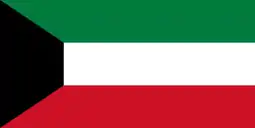 Kuwait: Is in transition to DVB-T2, stewarded by GatesAir. Phase 2 of the DTT rollout was finished by May 2017.[239] No analog switch off date yet.
Kuwait: Is in transition to DVB-T2, stewarded by GatesAir. Phase 2 of the DTT rollout was finished by May 2017.[239] No analog switch off date yet. Macau: Adopted the DTMB standard as Mainland China and Hong Kong in 2008.[240] Analog broadcasting will officially end in 2020 at 00:00 MOT when all analog broadcasts and analog transmitters will be turned off.
Macau: Adopted the DTMB standard as Mainland China and Hong Kong in 2008.[240] Analog broadcasting will officially end in 2020 at 00:00 MOT when all analog broadcasts and analog transmitters will be turned off. Myanmar: Digital broadcasts launched in 2013. The switchover date has been set to be December 2020.[241]
Myanmar: Digital broadcasts launched in 2013. The switchover date has been set to be December 2020.[241] Nepal: Digital terrestrial broadcasts launched in 2018.[242] That same year, analog cable television was shut in the capital Kathmandu.[243]
Nepal: Digital terrestrial broadcasts launched in 2018.[242] That same year, analog cable television was shut in the capital Kathmandu.[243] Oman: The process started in 2012 with the deployment of a DVB-T2 system. No completion date yet.[172]
Oman: The process started in 2012 with the deployment of a DVB-T2 system. No completion date yet.[172] Philippines: In June 2010, the National Telecommunications Commission set a deadline of 11:59 p.m. on 31 December 2015 for the discontinuation of analog television. However, since the last quarter of 2014, the digitization deadline has been postponed to 2019[244] and should be expected that all analog broadcasts will be shut off in 2023.[26] ZOE Broadcasting Network's DZOZ-TV became the first station in the country to permanently cease analog terrestrial operations on 28 February 2017,[245] signaling the start of the country's transition to digital-only broadcasting. Digital television in the Philippines uses the Japanese ISDB standards for its terrestrial broadcast.
Philippines: In June 2010, the National Telecommunications Commission set a deadline of 11:59 p.m. on 31 December 2015 for the discontinuation of analog television. However, since the last quarter of 2014, the digitization deadline has been postponed to 2019[244] and should be expected that all analog broadcasts will be shut off in 2023.[26] ZOE Broadcasting Network's DZOZ-TV became the first station in the country to permanently cease analog terrestrial operations on 28 February 2017,[245] signaling the start of the country's transition to digital-only broadcasting. Digital television in the Philippines uses the Japanese ISDB standards for its terrestrial broadcast.
Europe
 Turkey With the final analogue satellite broadcasts from TRT ended in February 2006, TRT launched trial digital transmissions in 2006 and originally planned to gradually handle the switchover, with a completion date of March 2015. In 2013 the broadcasting regulator awarded a license to a firm; the award was voided in 2014 after the country's constitutional court upheld a complaint against the process.[247] Although new licenses have been proposed in 2018 there was still no DTT network.[248][249] However, with the construction of a new "digital" transmitter in Küçük Çamlıca TV Radio Tower and Çanakkale TV Tower, digital broadcasts finally began testing in 2020.[250][251] As of 2020 there are 30+ FTA HD broadcasts with all popular and 5 TRT channels are avaiable by satellite and digital cable. There are plans building up to 40 more transmitters around the country, including the retrofit of Endem TV Tower.[252]
Turkey With the final analogue satellite broadcasts from TRT ended in February 2006, TRT launched trial digital transmissions in 2006 and originally planned to gradually handle the switchover, with a completion date of March 2015. In 2013 the broadcasting regulator awarded a license to a firm; the award was voided in 2014 after the country's constitutional court upheld a complaint against the process.[247] Although new licenses have been proposed in 2018 there was still no DTT network.[248][249] However, with the construction of a new "digital" transmitter in Küçük Çamlıca TV Radio Tower and Çanakkale TV Tower, digital broadcasts finally began testing in 2020.[250][251] As of 2020 there are 30+ FTA HD broadcasts with all popular and 5 TRT channels are avaiable by satellite and digital cable. There are plans building up to 40 more transmitters around the country, including the retrofit of Endem TV Tower.[252]
 Ukraine: All privately owned networks' analog broadcasts were switched off on 1 August 2018 in the Kyiv region, on 1 September 2018 in most parts of the country. The channels of UA:PBC were switched off in September 2018 - January 2019 in most parts of the country. Meanwhile, most channels in Russia-bordering regions, and some local channels (nationwide) that didn't yet get the license for digital broadcasting, will still broadcast in analog until 31 December 2020, after which they will be discontinuing analog broadcasts. However, in some areas, there are commercial channels staying in analog.
Ukraine: All privately owned networks' analog broadcasts were switched off on 1 August 2018 in the Kyiv region, on 1 September 2018 in most parts of the country. The channels of UA:PBC were switched off in September 2018 - January 2019 in most parts of the country. Meanwhile, most channels in Russia-bordering regions, and some local channels (nationwide) that didn't yet get the license for digital broadcasting, will still broadcast in analog until 31 December 2020, after which they will be discontinuing analog broadcasts. However, in some areas, there are commercial channels staying in analog.
Oceania
 Fiji Introduced its DVB-T2 digital terrestrial service called Walesi in testing phase 2016 and rolled out to public in December 2017. Switchover is planned to start in 2020. No completion date yet.[253]
Fiji Introduced its DVB-T2 digital terrestrial service called Walesi in testing phase 2016 and rolled out to public in December 2017. Switchover is planned to start in 2020. No completion date yet.[253] Kiribati DTT in DVB-T2 form was introduced with help from Papua New Guinea in 2018, first rolling out in the main island Tarawa. No completion date yet.[254][255]
Kiribati DTT in DVB-T2 form was introduced with help from Papua New Guinea in 2018, first rolling out in the main island Tarawa. No completion date yet.[254][255] Papua New Guinea Introduced DVB-T2. No switchover date yet.[256]
Papua New Guinea Introduced DVB-T2. No switchover date yet.[256] Samoa Introduced DTT publicly in 2019. No completion date yet.[257][258]
Samoa Introduced DTT publicly in 2019. No completion date yet.[257][258] Solomon Islands: Currently in transition. TTV broadcasts digital TV in DVB-T and T2.[259] However satellite is dominant in most of the country. No completion date yet.
Solomon Islands: Currently in transition. TTV broadcasts digital TV in DVB-T and T2.[259] However satellite is dominant in most of the country. No completion date yet. Tonga Started transition in 2015. No completion date yet.[260]
Tonga Started transition in 2015. No completion date yet.[260]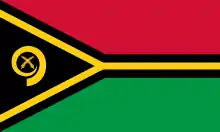 Vanuatu The main public channel made the switch to digital in October 2016. No completion date yet.[261]
Vanuatu The main public channel made the switch to digital in October 2016. No completion date yet.[261]
Transitions not yet started or planned
Africa
 Chad: Deployment of DTT is being planned as of 2017 together with StarTimes.[262] Government announced that year to accelerate the process.[263]
Chad: Deployment of DTT is being planned as of 2017 together with StarTimes.[262] Government announced that year to accelerate the process.[263] Djibouti: Public broadcaster RTD has made plans in 2018 to create a DTT network.[264]
Djibouti: Public broadcaster RTD has made plans in 2018 to create a DTT network.[264] Equatorial Guinea The transition is still being planned as of 2018.[265]
Equatorial Guinea The transition is still being planned as of 2018.[265] Guinea: A June 2018 meeting confirmed that a digital migration will start.[266]
Guinea: A June 2018 meeting confirmed that a digital migration will start.[266] Guinea-Bissau: The government partnered with StarTimes to create a DTT network.[267]
Guinea-Bissau: The government partnered with StarTimes to create a DTT network.[267] Liberia As of 2017, the country has been "optimistic" to start DTT broadcasts with help from the Chinese state's StarTimes.[268]
Liberia As of 2017, the country has been "optimistic" to start DTT broadcasts with help from the Chinese state's StarTimes.[268] Sao Tome and Principe planned in 2014 to make a transition to digital.[269] StarTimes has taken over the DTT process.[270][271]
Sao Tome and Principe planned in 2014 to make a transition to digital.[269] StarTimes has taken over the DTT process.[270][271] Sierra Leone: In June 2013, the country signed a deal with the Chinese StarTimes to manage a migration to digital TV.[272] However the process has been slow and there is still no DTT operating as of 2017.[273]
Sierra Leone: In June 2013, the country signed a deal with the Chinese StarTimes to manage a migration to digital TV.[272] However the process has been slow and there is still no DTT operating as of 2017.[273] Somaliland: A switchover to digital TV was part of the government's 2012-2016 National Development Plan.[274] However it missed the international 2015 deadline to launch its DTT network.
Somaliland: A switchover to digital TV was part of the government's 2012-2016 National Development Plan.[274] However it missed the international 2015 deadline to launch its DTT network. South Sudan The state broadcaster SSBC has expressed interest in DVB-T2, but no budget has been allocated for the project.
South Sudan The state broadcaster SSBC has expressed interest in DVB-T2, but no budget has been allocated for the project. Zimbabwe The DTT project started in 2015. However digital transmission has still not been rolled out as of 2019, mainly because of budgetary issues. The government is still committed to make the switchover.[275][35]
Zimbabwe The DTT project started in 2015. However digital transmission has still not been rolled out as of 2019, mainly because of budgetary issues. The government is still committed to make the switchover.[275][35]
Americas
 Barbados: As of 2012, public broadcaster CBC chose the ATSC standard for its future DTT network.[276]
Barbados: As of 2012, public broadcaster CBC chose the ATSC standard for its future DTT network.[276] Belize has not yet introduced DTT. Head of broadcasting division Ilham Ghazi and telecom director Justin Barrow said in September 2018 that a switchover is not currently planned as extra spectrum space is not demanded.[277]
Belize has not yet introduced DTT. Head of broadcasting division Ilham Ghazi and telecom director Justin Barrow said in September 2018 that a switchover is not currently planned as extra spectrum space is not demanded.[277]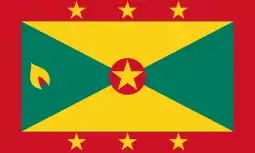 Grenada: Digital switchover still being planned as of 2014.[278]
Grenada: Digital switchover still being planned as of 2014.[278] Guatemala started testing ISDB-T broadcasts in December 2017, with the aim of rolling out the services soon and an analog switch off date of 2022.[279][280]
Guatemala started testing ISDB-T broadcasts in December 2017, with the aim of rolling out the services soon and an analog switch off date of 2022.[279][280] Guyana made a roadmap to a transition between 2014 and 2017. The DTT network is not yet rolled out.[281]
Guyana made a roadmap to a transition between 2014 and 2017. The DTT network is not yet rolled out.[281] Haiti: DTT made its experimental launch in December 2016, using the ATSC standard.[282][283]
Haiti: DTT made its experimental launch in December 2016, using the ATSC standard.[282][283] Nicaragua chose the ISDB-T standard in 2015. The first DTT trials began in March 2018.[284]
Nicaragua chose the ISDB-T standard in 2015. The first DTT trials began in March 2018.[284] Saint Lucia: According to a 2012 ITU report, no DTT is currently being planned in Saint Lucia.[285] Analogue cable transmissions were shut during 2013.[286]
Saint Lucia: According to a 2012 ITU report, no DTT is currently being planned in Saint Lucia.[285] Analogue cable transmissions were shut during 2013.[286] Trinidad and Tobago estimated to be completed by 2020 however this might not happen because even by 14 June 2020 no terrestrial TV station has switched to digital broadcasting yet. ATSC is still being considered.[287]
Trinidad and Tobago estimated to be completed by 2020 however this might not happen because even by 14 June 2020 no terrestrial TV station has switched to digital broadcasting yet. ATSC is still being considered.[287]
Asia
 Cambodia: DVB-T2 was launched on Tuesday, 9 November 2010,[288] however as at 23 December 2019 the only FTA DVB-T channels appear to be pay TV channels that the provider has erroneously neglected to encrypt. The incumbent FTA channels have thus far not provided DVB-T broadcasts. The Cambodian government have pushing ahead its co-operation with China for the digital transition from analogue with China's DTMB system.[17] Full digital transition is estimated by the government to fully commenced by 2023.[25]
Cambodia: DVB-T2 was launched on Tuesday, 9 November 2010,[288] however as at 23 December 2019 the only FTA DVB-T channels appear to be pay TV channels that the provider has erroneously neglected to encrypt. The incumbent FTA channels have thus far not provided DVB-T broadcasts. The Cambodian government have pushing ahead its co-operation with China for the digital transition from analogue with China's DTMB system.[17] Full digital transition is estimated by the government to fully commenced by 2023.[25] Laos: Lao National Television joined China's Yunnan Digital TV Company to establish Lao Digital TV with DTMB system in 2007.[289] Lao Deputy Minister of Information, Culture and Tourism Savankhone Razmountry further state that their country was making every effort to fully switch from the analogue television system to DTMB by 2020.[17]
Laos: Lao National Television joined China's Yunnan Digital TV Company to establish Lao Digital TV with DTMB system in 2007.[289] Lao Deputy Minister of Information, Culture and Tourism Savankhone Razmountry further state that their country was making every effort to fully switch from the analogue television system to DTMB by 2020.[17] Lebanon: In January 2015 a pilot project on DTT was launched from Télé Liban broadcasting sites.[290] The service is not yet publicly rolled out.
Lebanon: In January 2015 a pilot project on DTT was launched from Télé Liban broadcasting sites.[290] The service is not yet publicly rolled out. Maldives: In 2015 the Maldives picked the ISDB-T standard for its DTT network. The service is yet to roll out.
Maldives: In 2015 the Maldives picked the ISDB-T standard for its DTT network. The service is yet to roll out. North Korea: It was reported in 2013 that North Korea had tested digital broadcasting trials in 2012.[291]DVB-T2 was adopted as digital terrestrial television broadcast standard[292] On 19 January 2015, Korean Central Television, the country's state broadcaster, began broadcasting via digital satellite. However, there is no confirmed plan yet to introduce digital terrestrial broadcasts.[293][294]
North Korea: It was reported in 2013 that North Korea had tested digital broadcasting trials in 2012.[291]DVB-T2 was adopted as digital terrestrial television broadcast standard[292] On 19 January 2015, Korean Central Television, the country's state broadcaster, began broadcasting via digital satellite. However, there is no confirmed plan yet to introduce digital terrestrial broadcasts.[293][294] Pakistan: In 2015, Pakistan inaugurated the adoption of the DTMB standard for the country digital television broadcasts in an event jointly officiated by Chinese President Xi Jinping and Pakistani Prime Minister Nawaz Sharif.[295] The first DTMB services were then tested with the signing of a memorandum of understanding (MoU) between Pakistani Ministry of Information and Broadcasting and China's National Development and Reform Commission.[18] A pilot project was successfully completed in 2018 for $2 million. It is expected that the system would roll out to the public in 2020.[296][297]
Pakistan: In 2015, Pakistan inaugurated the adoption of the DTMB standard for the country digital television broadcasts in an event jointly officiated by Chinese President Xi Jinping and Pakistani Prime Minister Nawaz Sharif.[295] The first DTMB services were then tested with the signing of a memorandum of understanding (MoU) between Pakistani Ministry of Information and Broadcasting and China's National Development and Reform Commission.[18] A pilot project was successfully completed in 2018 for $2 million. It is expected that the system would roll out to the public in 2020.[296][297] Palestine: A digital switchover has been planned by the Palestinian Authority as of 2013, although its rollout has been delayed.[298]
Palestine: A digital switchover has been planned by the Palestinian Authority as of 2013, although its rollout has been delayed.[298] Sri Lanka: Television industry in Sri Lanka has been preparing to digitalise itself for more than half a decade but government policy of uncertainties have confused broadcasters and caused many delays.[299] A 2014 television digitisation deal between Sri Lankan previous government and Japan are delayed up until present. In 2018, a Sri Lankan company named Television and Radio Network (TRN) offering to launch nationwide free digital television switch using the DVB-T2 system in contrast to Japanese proposal of ISDB-T system.[299]
Sri Lanka: Television industry in Sri Lanka has been preparing to digitalise itself for more than half a decade but government policy of uncertainties have confused broadcasters and caused many delays.[299] A 2014 television digitisation deal between Sri Lankan previous government and Japan are delayed up until present. In 2018, a Sri Lankan company named Television and Radio Network (TRN) offering to launch nationwide free digital television switch using the DVB-T2 system in contrast to Japanese proposal of ISDB-T system.[299] Syria: Because of the conflict in Syria, the launch of a DTT network and a transition has been put on hold as of 2016.[300]
Syria: Because of the conflict in Syria, the launch of a DTT network and a transition has been put on hold as of 2016.[300] Tajikistan: The country adopted DVB-T2 in 2014. The government planned to start transitioning in 2015,[301] although this has not occurred as of yet. The exclusion of private broadcasters and stakeholders is one of the reasons for the delay.[302]
Tajikistan: The country adopted DVB-T2 in 2014. The government planned to start transitioning in 2015,[301] although this has not occurred as of yet. The exclusion of private broadcasters and stakeholders is one of the reasons for the delay.[302] Timor-Leste: On 11 December 2018, the Timor-Leste cabinet has given Secretary of State for Social Communication Merício Juvenal dos Reis permission to sign a Sino-Timor-Leste agreement for the introduction of Chinese digital television format of DTMB into the country.[303] On 18 June 2019, the groundbreaking ceremony for the China-aided demonstration project of the DTMB was held at the China Radio and Television Station in Timor-Leste.[304] The work subsequently began on 21 June.[305]
Timor-Leste: On 11 December 2018, the Timor-Leste cabinet has given Secretary of State for Social Communication Merício Juvenal dos Reis permission to sign a Sino-Timor-Leste agreement for the introduction of Chinese digital television format of DTMB into the country.[303] On 18 June 2019, the groundbreaking ceremony for the China-aided demonstration project of the DTMB was held at the China Radio and Television Station in Timor-Leste.[304] The work subsequently began on 21 June.[305]
Europe
 Abkhazia: The telecom chairman Lasha Shamba said in 2019 that there is a project in managing a digital switch but that the territory is not ready yet due to lack of funding. The analog switch off in Russia is proving to cause problems for Abkhazians who currently watch Russian relay terrestrial broadcasts in analog.[306]
Abkhazia: The telecom chairman Lasha Shamba said in 2019 that there is a project in managing a digital switch but that the territory is not ready yet due to lack of funding. The analog switch off in Russia is proving to cause problems for Abkhazians who currently watch Russian relay terrestrial broadcasts in analog.[306] Bosnia and Herzegovina : There was a DVB-T service launched in 2015 but it wasn't available on all parts of the country. Currently there is no date for the switchover.
Bosnia and Herzegovina : There was a DVB-T service launched in 2015 but it wasn't available on all parts of the country. Currently there is no date for the switchover. Kosovo: The government published a plan for a switchover in 2015.[307] As of 2019 however, there is no DTT network in operation yet.
Kosovo: The government published a plan for a switchover in 2015.[307] As of 2019 however, there is no DTT network in operation yet. South Ossetia: DTT is not yet rolled out in the territory. Its creation has been postponed due to lack of funds.[308]
South Ossetia: DTT is not yet rolled out in the territory. Its creation has been postponed due to lack of funds.[308]
No information available
 Anguilla
Anguilla.svg.png.webp) Antarctica
Antarctica Aruba
Aruba Ascension Island
Ascension Island Ashmore and Cartier Islands
Ashmore and Cartier Islands British Virgin Islands
British Virgin Islands Central African Republic
Central African Republic Cook Islands
Cook Islands Dominica
Dominica Eritrea
Eritrea Marshall Islands
Marshall Islands Mauritania
Mauritania Montserrat
Montserrat Pitcairn Islands
Pitcairn Islands Sahrawi Arab Democratic Republic
Sahrawi Arab Democratic Republic Saint Kitts and Nevis
Saint Kitts and Nevis Saint Vincent and the Grenadines
Saint Vincent and the Grenadines Somalia
Somalia South Georgia and the South Sandwich Islands
South Georgia and the South Sandwich Islands Tokelau
Tokelau Tristan da Cunha
Tristan da Cunha Turkmenistan
Turkmenistan Tuvalu
Tuvalu Yemen
Yemen
See also
References
- https://www.itu.int/dms_pub/itu-r/opb/rep/R-REP-BT.2140-3-2011-PDF-E.pdf
- Sterling, Toby (11 December 2006). "Dutch pull plug on free analog TV". msnbc.com. Archived from the original on 26 May 2018. Retrieved 25 May 2018.
- Landler, Mark (3 November 2003). "TECHNOLOGY; German Way To Go Digital: No Dawdling". Archived from the original on 26 May 2018. Retrieved 25 May 2018 – via NYTimes.com.
- van der Sloot, Bart (September 2011). "Mapping Digital Media: How Television Went Digital in the Netherlands". Open Society Foundations. Archived from the original on 14 August 2019. Retrieved 14 August 2019.
- "2016 White Paper – [Table 5] World countries which are completed transition to Digital Terrestrial Television Broadcasting" (PDF). Communications and Information Technology Authority, Mongolia. 2 March 2015. p. 17/50. Archived (PDF) from the original on 9 August 2017. Retrieved 24 July 2019.
- "Penutupan siaran televisyen analog 31 Disember ini" [The closure of analogue television broadcast this 31 December] (in Malay). Pelita Brunei. 23 December 2017. Archived from the original on 25 July 2019. Retrieved 25 July 2019.
- "EXCLUSIV Românii fără acces la televiziune digitală nu mai pot recepționa TVR1 de la 1 mai 2018 - Telecom - HotNews.ro". economie.hotnews.ro. 7 May 2018. Archived from the original on 13 May 2018. Retrieved 13 May 2018.
- "Deadline for end of analogue TV broadcast extended to end-2018: IMDA". Channel NewsAsia. 6 November 2017. Archived from the original on 6 November 2017. Retrieved 7 November 2017.
- "5 things to know about digital TV before analogue TV transmissions cease from 2 Jan". Straits Times. 21 December 2018. Archived from the original on 1 January 2019. Retrieved 1 January 2019.
- "Digital television to replace analogue beginning next year". 29 September 2018. Archived from the original on 5 September 2019. Retrieved 24 September 2019.
- "Gobind: Full shutdown of analogue TV broadcast by third quarter of 2019". The Star. 2 April 2019. Archived from the original on 14 April 2019. Retrieved 19 July 2019.
- Afiq Aziz; Muhd Amin Naharul (27 May 2019). "Govt to switch to digital TV by September". The Malaysian Reserve. Archived from the original on 28 May 2019. Retrieved 19 July 2019.
- "Public to enjoy digital television by October". New Straits Times. 18 May 2019. Archived from the original on 19 July 2019. Retrieved 19 July 2019.
- Puprasert, Jenpasit (28 January 2020). ""26 มี.ค. 63" ดีเดย์ช่อง 3 ยุติอนาล็อก พร้อมเผยแผน Next Move 2020" [“26 Mar 20” D-Day Channel 3 terminates analogue and reveals plans for Next Move 2020]. yamfaojor.com (in Thai). Archived from the original on 1 February 2020. Retrieved 15 August 2020.
- "Chính thức hoàn thành số hóa truyền hình từ 0h ngày 28/12" [Officially complete the digitisation of television from 0:00 on 28/12] (in Vietnamese). Vietnam Television. 27 December 2020. Retrieved 31 December 2020.
The provinces mentioned in the final analogue switch-off include: Hà Giang, Cao Bằng, Bắc Kạn, Tuyên Quang, Lào Cai, Yên Bái, Lạng Sơn, Điện Biên, Lai Châu, Sơn La, Hòa Bình, Kontum, Gia Lai, Đắklắk and Đắc Nông.
- Trọng Đạt (28 December 2020). "Các tỉnh cuối cùng đã ngừng phát sóng truyền hình analog" [Provinces have finally ceased analogue television broadcasting] (in Vietnamese). Vietnam Net. Archived from the original on 31 December 2020. Retrieved 31 December 2020.
Since last night (at 0:00 on 28 December 2020), 15 more provinces have stopped broadcasting analogue terrestrial television. These are the provinces in group IV and also the last ones to stop broadcasting analogue terrestrial television according to the plan of the project "Digitisation of television".
- ZX (29 August 2018). "Laos, Cambodia forge ahead with China on digital TV cooperation". Xinhua News Agency. Archived from the original on 25 July 2019. Retrieved 25 July 2019.
- Amar Ayaz (10 January 2017). "The CPEC plan for Pakistan's digital future". Dawn. Archived from the original on 25 July 2019. Retrieved 25 July 2019.
- http://www.indotel.gob.do/index.php/cgblog/2246/Ejecutivo-pospone-implementacion-de-television-digital
- Bertran, Agustin (8 March 2019). "Colombia posterga el apagón analógico para 2021". NexTV News Latin America. Archived from the original on 19 March 2019. Retrieved 11 March 2019.
- https://www.elintransigente.com/sociedad/2019/3/8/extienden-el-plazo-para-realizar-el-apagon-analogico-de-la-television-546578.html%5B%5D
- https://africanews.space/south-africa-to-complete-its-broadcasting-digital-migration-bdm-by-2021/#:~:text=South%20Africa%20will%20switch%20from,its%20National%20Department%20of%20Communication.&text=Currently%2C%20South%20Africa%20is%20five,from%20analogue%20to%20digital%20transmission.
- "Jakarta Siap Menyosong ASO Penyiaran TV Digital Terestrial 2021". ANTVKLIK (in Indonesian). 28 January 2021. Retrieved 29 January 2021.
- Liputan6.com (3 December 2020). "Kemkominfo Tegaskan Migrasi TV Analog ke Digital Paling Lambat November 2022". liputan6.com (in Indonesian). Retrieved 4 December 2020.
- Kong Meta (4 January 2019). "Digital TV channels set to air in Kingdom". The Phnom Penh Post. Archived from the original on 25 July 2019. Retrieved 25 July 2019.
- Cabuenas, Jon Viktor D. (14 February 2017). "Gov't wants analog TV switched off by 2023". GMA News Online. Archived from the original on 15 February 2017. Retrieved 15 February 2017.
- "DigiTAG Analog Switch Off Handbook" (PDF). 2008. Archived from the original (PDF) on 28 September 2011. Retrieved 13 May 2009.
- "Terrestrial Frequently Asked Questions (FAQ): Browse by categories". itu.int. Archived from the original on 30 September 2019. Retrieved 30 September 2019.
- Itagaki, T.; Owens, T.; Orero, P. (20 May 2016). "Digital TV accessibility — Analogue switch off in Europe and Africa". 2016 IST-Africa Week Conference. pp. 1–8. doi:10.1109/ISTAFRICA.2016.7530658. ISBN 978-1-9058-2455-7. S2CID 43649485.
- "DSO slows down in ASEAN". 12 March 2018. Archived from the original on 29 September 2019. Retrieved 29 September 2019.
- "Official Journal of the European Union". eur-lex.europa.eu. 28 October 2009. Archived from the original on 22 May 2013. Retrieved 13 January 2014.
- "News" (PDF). DVB. Archived (PDF) from the original on 10 May 2012. Retrieved 13 January 2014.
- "Archived copy". Archived from the original on 25 September 2019. Retrieved 25 September 2019.CS1 maint: archived copy as title (link)
- "Cabo Verde espera desligar TV analógica ainda este ano". cmjornal.pt. Archived from the original on 26 September 2019. Retrieved 26 September 2019.
- "Archived copy" (PDF). Archived (PDF) from the original on 24 September 2019. Retrieved 25 September 2019.CS1 maint: archived copy as title (link)
- La, Rédaction (22 May 2015). "Gabon: the migration to digital television costs 60 billion FCFA". Africa Top Success. Archived from the original on 11 December 2017. Retrieved 10 December 2017.
- "TV signals to go digital by June 2015 - MyJoyOnline.com". myjoyonline.com. Archived from the original on 10 March 2016. Retrieved 9 March 2016.
- "Archived copy". Archived from the original on 30 September 2019. Retrieved 30 September 2019.CS1 maint: archived copy as title (link)
- "Rwanda, Tanzania lead in switchover to digital TV". The East African. Archived from the original on 20 December 2019. Retrieved 20 December 2019.
- Weidemann, Rodney (21 February 2005). "Namibia gets digital terrestrial TV". ITWeb. Archived from the original on 30 September 2019. Retrieved 30 September 2019.
- "Welcome digitaltvafrica.com - BlueHost.com". digitaltvafrica.com. Archived from the original on 11 March 2016. Retrieved 9 March 2016.
- McLeod, Duncan (3 February 2016). "Finally, digital TV era arrives in SA". TechCentral.co.za. Archived from the original on 9 March 2016. Retrieved 18 September 2016.
- Odendaal, Natasha (28 October 2016). "Analogue transmission switch-off starts in Northern Cape as South Africa progresses digital migration". Engineeringnews.co.za. Engineering News. Archived from the original on 10 March 2018. Retrieved 23 February 2018.
- van Zyl, Gareth (17 June 2015). "SA joins list of losers on digital migration". Fin24.com. Archived from the original on 8 March 2018. Retrieved 7 March 2018.
- Herman, Paul (23 January 2018). "Communications department needs R6.6bn to complete digital migration by 2019 deadline". News24.com. Archived from the original on 24 February 2018. Retrieved 23 February 2018.
- "South Africa vows fast action on digital TV". advanced-television.com. Archived from the original on 30 September 2019. Retrieved 30 September 2019.
- "Nigeria's digital migration failure: Lessons from Tanzania". 23 June 2015. Archived from the original on 11 December 2017. Retrieved 20 December 2019.
- "Uganda's Digital TV Migration is complete but where's the EPG Data? | Migration to Digital TV in Uganda – A community blog for geeks with status updates". Archived from the original on 25 September 2019. Retrieved 25 September 2019.
- "Digital Television Migration". mibs.gov.sg. Archived from the original on 10 December 2017. Retrieved 10 December 2017.
- "Digital Terrestrial Television (DTT) - World Map (high resolution)". dtvstatus.net.
- "BBC's All-Digital TV Output Plans "On Course"". bernews.com. 9 March 2016. Archived from the original on 10 December 2017. Retrieved 10 December 2017.
- "Archived copy". Archived from the original on 25 September 2019. Retrieved 25 September 2019.CS1 maint: archived copy as title (link)
- Bustillo, Yony (29 January 2019). "Inicia cuenta regresiva para apagón analógico en sistemas de televisión de Honduras". El Heraldo. Archived from the original on 8 February 2019. Retrieved 23 June 2019.
- "México avanza hacia el Apagón analógico" (in Spanish). Generaccion.com. 3 September 2010. Archived from the original on 6 October 2011. Retrieved 1 August 2012.
- "México posterga 'apagón analógico'" (in Spanish). Univision. 1 June 2013. Archived from the original on 28 September 2013. Retrieved 11 June 2013.
- "Posible, concluir apagón analógico en 2015: Cofetel" (in Spanish). El Economista. 3 June 2013. Archived from the original on 15 June 2013. Retrieved 11 June 2013.
- Labaton, Stephen (5 June 2009). "Millions Still Not Ready for Digital TV". Archived from the original on 26 September 2019. Retrieved 26 September 2019 – via NYTimes.com.
- "BNamericas - Argentina joins Colombia in pushing back dig..." BNamericas.com. Archived from the original on 26 September 2019. Retrieved 26 September 2019.
- "Invoering digitale televisie zorgt voor meer tv-plezier • Surgoed Makelaardij NV". Surgoed Makelaardij NV. Archived from the original on 25 September 2019. Retrieved 25 September 2019.
- "Get BFBS | BFBS Welfare". 15 April 2019. Archived from the original on 15 April 2019.
- "Digital TV". Government of Hong Kong. Archived from the original on 20 June 2007. Retrieved 4 June 2007.
- "Hong Kong to enter era of full digital TV broadcast tomorrow". Government of Hong Kong. Archived from the original on 1 December 2020. Retrieved 1 December 2020.
- Ng Kang-chung; Sum Lok-kei; Su Xinqi (11 February 2019). "Low-income households to get subsidies for digital TV sets when Hong Kong's analogue era draws to a close next year". South China Morning Post. Archived from the original on 22 August 2020. Retrieved 22 August 2020.
- "Terrestrial digital broadcasting: analog broadcasts end in Suzu, Ishikawa". Mainichi Shimbun. 24 July 2010. Archived from the original on 1 May 2013. Retrieved 24 July 2010.
- 岩手、宮城、福島の3県のアナログ放送は平成24年3月31日に終了しました [Analog broadcast ended in Iwate, Miyagi and Fukushima on 31 March 2012 (year Heisei 24)] (in Japanese). Tokyo: Ministry of Internal Affairs and Communications. 31 March 2012. Archived from the original on 20 March 2012. Retrieved 1 April 2012.
- "Broadcasting Digitization Schedule". DPA: The Association for Promotion of Digital Broadcasting. Archived from the original on 10 December 2009. Retrieved 16 November 2009.
- "デジアナ変換が4月末で"混乱なく"完全終了。テレビはどれだけ売れた?". AV Watch. 18 May 2015. Archived from the original on 9 May 2019. Retrieved 20 December 2019.
- Moseychuk, Vitaly. "Kyrgyzstan Switches TV Broadcasting to Digital Format | Mediasat English". Archived from the original on 24 September 2019. Retrieved 24 September 2019.
- Goh Thean Eu (16 June 2014). "Telco Deep Dive: Two sides of Malaysia's Digital TV story". Digital News Asia. Archived from the original on 19 July 2019. Retrieved 19 July 2019.
- "Syed Mokhtar company wins digital Terrestrial TV tender". Digital News Asia. 8 January 2014. Archived from the original on 19 July 2019. Retrieved 19 July 2019.
- "PM launches myFreeview digital broadcast, 4.2m decoders to be given free". The Malay Mail. 6 June 2017. Archived from the original on 19 July 2019. Retrieved 19 July 2019.
- Alexander Wong (21 July 2019). "Analogue TV switched off in Langkawi, nationwide switchover to happen later". SoyaCincau. Archived from the original on 24 July 2019. Retrieved 24 July 2019.
- Nic Ker (6 August 2019). "Malaysia switching to digital TV transmission, govt to stop analogue transmission when "prepared"". SoyaCincau. Archived from the original on 6 August 2019. Retrieved 6 August 2019.
- "MCMC: Malaysia switching to full digital TV broadcast by 31 Oct". The Malay Mail. 24 September 2019. Archived from the original on 25 September 2019. Retrieved 25 September 2019.
- Alexander Wong (25 September 2019). "Malaysia to turn off analogue TV completely on 31 Oct". SoyaCincau. Archived from the original on 25 September 2019. Retrieved 25 September 2019.
- Alexander Wong (16 October 2019). "West Malaysia has completely switched over from Analogue to Digital TV". SoyaCincau. Archived from the original on 16 October 2019. Retrieved 16 October 2019.
- "Malaysia Beralih Kepada Siaran TV Digital Secara Sepenuhnya Pada 31 Oktober 2019" [Malaysia Turns Into Digital TV Broadcast On 31 October 2019] (PDF) (Press release) (in Malay). Malaysian Communications and Multimedia Commission. 2 April 2019. Archived from the original (PDF) on 1 November 2019. Retrieved 1 November 2019.
- "Sabah and Sarawak switch to digital TV". The Star. 31 October 2019. Archived from the original on 31 October 2019. Retrieved 1 November 2019.
- "Now entire nation enjoys digital TV broadcast". Bernama. The Borneo Post. 1 November 2019. Archived from the original on 1 November 2019. Retrieved 1 November 2019.
- "Negara ucap selamat tinggal kepada TV analog" [The country says goodbye to analogue TV]. Bernama (in Malay). Astro Awani. 1 November 2019. Archived from the original on 1 November 2019. Retrieved 1 November 2019.
- 경상북도 울진군, 오늘부터 '디지털 송출' 시작 (in Korean). sbs.co.kr. 20 January 2010. Archived from the original on 4 September 2014. Retrieved 11 June 2013.
- "South Korea to continue analog TV near border". North Korea Tech. 27 December 2012. Archived from the original on 27 May 2013. Retrieved 11 June 2013.
- "MCI's Addendum to the President's Address". Mci.gov.sg. Archived from the original on 24 January 2016. Retrieved 21 January 2016.
- "A reminder to Singapore households: Switch to digital TV". Channel NewsAsia. 7 September 2018. Archived from the original on 2 January 2019. Retrieved 2 January 2019.
- "Premier calls for full digitization of cable TV". Executive Yuan. 30 June 2012. Retrieved 22 August 2020.
- Lee I-chia (1 July 2012). "Final analog broadcast marks full switch to digital". Taipei Times. Archived from the original on 30 August 2020. Retrieved 30 August 2020.
- Su, Herng; Chang, Shi-Chung (2015). "New Television and Old Campaign: The Experience and Lessons in Digital Television Transition in Taiwan". Journalism and Mass Communication. 2. doi:10.15344/2349-2635/2015/111.
- Supatrasit Suansook (2015). "Digital Terrestrial Television in Thailand: Technical Aspects" (PDF). National Broadcasting and Telecommunications Commission of Thailand. Archived (PDF) from the original on 25 July 2019. Retrieved 25 July 2019.
- John Fernquest (24 March 2014). "Digital TV: What do I need to know?". Bangkok Post. Retrieved 25 July 2019.
- Theadora Mills (28 June 2018). "In rural areas of Thailand, local TV is going digital". ITU News. Archived from the original on 25 July 2019. Retrieved 25 July 2019.
- DBC37ThailandNews (25 March 2020). "Historical of Switch-off Analogue TV By Channel 3 on UHF-32(Thai Language)". Youtube. Retrieved 28 March 2020.
- "TV Digital broadcasting in Viet Nam" (PDF). Ministry of Information and Communications, Vietnam. 2014. p. 17/17. Archived (PDF) from the original on 23 September 2019. Retrieved 7 December 2019 – via International Telecommunication Union.
- Phong Quốc, Sỉ (22 November 2019). "Truyền hình kỹ thuật số mặt đất là gì? Tivi tích hợp DVB-T2 có lợi gì?" [What is terrestrial digital TV? What is the benefit of integrated DVB-T2 TV?]. thegioididong.com (in Vietnamese). Archived from the original on 16 August 2020. Retrieved 17 August 2020.
- Việt Nga (2 December 2019). "Dành băng tần "kim cương" cho dịch vụ di động" [Reserving the "diamond" band for mobile services] (in Vietnamese). Hànộimới. Archived from the original on 7 December 2019. Retrieved 7 December 2019.
Thủ tướng Chính phủ đã ban hành Quyết định số 2451/QĐ-TTg phê duyệt Đề án "Số hóa truyền dẫn, phát sóng truyền hình mặt đất đến năm 2020" (gọi tắt là Đề án Số hóa truyền hình), trong đó quy định trước ngày 31-12-2020 kết thúc phát sóng truyền hình analog tại 63 tỉnh, thành phố chuyển sang truyền hình số mặt đất.
- "Vietnam continues switching off analogue TV signals in 15 provinces". Nhân Dân. 15 August 2017. Archived from the original on 9 December 2017. Retrieved 19 December 2017.
- Trọng Đạt (30 June 2020). "Từ đêm nay 30/6, 21 tỉnh sẽ ngừng phát sóng truyền hình analog" [From tonight 30/6, 21 provinces will stop broadcasting analogue television] (in Vietnamese). Vietnam Net. Archived from the original on 22 August 2020. Retrieved 22 August 2020.
The provinces mentioned in the analogue switch-off include: Quảng Ninh, Thái Nguyên, Ninh Bình, Bắc Giang, Phú Thọ, Đồng Nai, Bình Thuận, Bà Rịa - Vũng Tàu, Khánh Hòa, Thanh Hóa, Nghệ An, Hà Tĩnh, Quảng Bình, Quảng Trị, Thừa Thiên Huế, Quảng Nam, Quảng Ngãi, Bình Định, Phú Yên, Lâm Đồng and Ninh Thuận.
- "Albanian digital TV concerns mount". Broadband TV News. 7 January 2016. Archived from the original on 24 September 2019. Retrieved 24 September 2019.
- "Archived copy" (PDF). Archived (PDF) from the original on 16 August 2019. Retrieved 23 September 2019.CS1 maint: archived copy as title (link)
- "Andorra fa el salt a la TDT" (in Catalan). Vilaweb. Archived from the original on 13 February 2008. Retrieved 10 March 2008.
- "DVB-T: Zeitplan". Digitales Fernsehen Förder GmbH. June 2008. Archived from the original on 2 July 2008. Retrieved 23 June 2008.
- "analog terrestrial TV switch-off in the EU - briefing – EUbusiness.com - EU Business News". Eubusiness.com. Archived from the original on 2 April 2012. Retrieved 1 August 2012.
- "Azerbaijan to switch over to digital TV 'very soon'". News.Az. 27 September 2011. Archived from the original on 6 October 2011. Retrieved 1 August 2012.
- "In 2013, Azerbaijan will fully switch to digital TV - Minister". News.Az. 3 December 2012. Retrieved 10 December 2012.
- "Комисия За Регулиране На Съобщенията". Crc.bg. Archived from the original on 27 August 2009. Retrieved 12 August 2009.
- Webfactory www.webfactory.ie. "Digital Video Broadcasting — Bulgaria". DVB. Archived from the original on 15 August 2009. Retrieved 12 August 2009.
- "Bulgarian DTT woes continue". Broadband TV News. 12 July 2012. Archived from the original on 10 September 2013. Retrieved 5 September 2012.
- "Аналоговият ТВ сигнал спрян окончателно, 100 000 са без телевизия". Dnes.dir.bg.
- "Archived copy". Archived from the original on 7 October 2010. Retrieved 2 December 2010.CS1 maint: archived copy as title (link)
- "Nyt TV-signal fejres med lysshow". TVTid på TV2. Archived from the original on 5 November 2009. Retrieved 1 November 2009.
- "Ændringer i din tv-pakke". YouSee. Archived from the original on 22 December 2015. Retrieved 14 December 2015.
- "Analog satellit TV". ullits.dk. Archived from the original on 9 November 2013. Retrieved 29 September 2019.
- "Grønland digitaliserer tv-sendenet". Computerworld. 23 May 2002. Archived from the original on 25 September 2019. Retrieved 25 September 2019.
- "Digitalt tv dækker snart hele landet". KNR. Archived from the original on 26 October 2016. Retrieved 20 December 2019.
- "DVB - Digital Video Broadcasting - Faroe Islands". 16 January 2013. Archived from the original on 16 January 2013.
- "Digi-tv esillä ympäri maata". Finnish Ministry of Communications. Archived from the original on 27 September 2007. Retrieved 12 August 2007.
- "Archived copy". Archived from the original on 3 September 2017. Retrieved 3 September 2017.CS1 maint: archived copy as title (link)
- Стоянова, Алиса. "Грузия пока не отключает аналог | Mediasat". Archived from the original on 2 July 2015. Retrieved 1 July 2015.
- "Digea". digea.gr. Archived from the original on 8 December 2019. Retrieved 8 December 2019.
- "Digea". digea.gr. Archived from the original on 2 September 2018. Retrieved 8 December 2019.
- "Map coverage Broadcast Centres". Directorate General of Technology and Development. Archived from the original on 8 February 2015. Retrieved 2 February 2015.
- "Announcement". Digea. December 2014. Archived from the original on 6 February 2015.
ANNOUNCEMENT Saturday, 27 December 2014 the morning will begin digital broadcasting (while stopping analogue) of the centers: Agios Athanasios Water Tower Gate Tsotyli Vounasa Royal Polygyros Delvinaki Curse Granitsopoula Igoumenitsa Korfovouni Amfilochia Those viewers covered by these centers will need to have receiver (TV or decoder) that supports MPEG4 technology and coordinate the morning of 27 December the new frequencies. Those viewers already receive terrestrial digital TV signal need not make any action.
- "Digea Press release 26/02/15" (in Greek). Archived from the original on 8 December 2019.
- "Digital Television". Icelandic National Broadcasting Service. Archived from the original on 26 June 2015. Retrieved 24 June 2015.
- "Turning off the analogue distribution". Icelandic National Broadcasting Service. 2 February 2015. Archived from the original on 3 April 2015. Retrieved 2 February 2015.
- "Watershed in Icelandic telecommunications history". Vodafone. 2 February 2015. Archived from the original on 15 March 2015. Retrieved 2 February 2015.
- "Home - Going Digital". DigitalTelevision.ie. 4 June 2012. Archived from the original on 4 October 2011. Retrieved 1 August 2012.
- "Digital switchover takes place". The Irish Times. 24 October 2012. Archived from the original on 24 October 2012. Retrieved 24 October 2012.
- "analog Deflectors still in service until 31 December". boards.ie. Archived from the original on 13 January 2014. Retrieved 13 January 2014.
- Hooper, John (13 October 2006). "Silvio Berlusconi Italy digital TV Mediaset Prodi RAI". Archived from the original on 29 September 2019. Retrieved 29 September 2019 – via www.theguardian.com.
- "EU court strikes Berlusconi's media empire". 29 July 2011. Archived from the original on 29 September 2019. Retrieved 29 September 2019.
- Traisci, Francesco Paolo. "I diritti audiovisivi: una storia lunga e piena di colpi di scena – 7. Satellite e digitale terrestre". Archived from the original on 20 September 2019. Retrieved 20 September 2019.
- Italradio, Portale. "Satellite: RAI International lascia l'analogico per il digitale". portale.italradio.org.
- "Паром в Моловате: между двумя Молдовами". 1News.md | Информационный Портал. Archived from the original on 28 September 2019. Retrieved 28 September 2019.
- "Сайт Государственной службы связи, информации и СМИ ПМР - Цифровое эфирное телевещание". 4 November 2013. Archived from the original on 4 November 2013.
- "О трансляции телевизионных программ в стандарте DVB-T2". minregion.gospmr.org. Archived from the original on 28 September 2019. Retrieved 28 September 2019.
- "В ближайшие два года Приднестровье планирует полностью перейти на цифровое телевидение | Новости Приднестровья".
- "Digitalization of all Macedonian televisions by 2013". Ministry of Information Society and Administration. 14 March 2012. Archived from the original on 3 December 2013. Retrieved 15 March 2012.
- "Yayın Yüksek Kurulu". kktcyyk.org. Archived from the original on 30 September 2019. Retrieved 30 September 2019.
- Webfactory http://www.webfactory.ie. "Digital Video Broadcasting - Malta". DVB. Archived from the original on 24 August 2012. Retrieved 1 August 2012.
- "Montenegro shuts down the analogue signal". CDM. Archived from the original on 29 September 2015. Retrieved 17 June 2015.
- "Ziggo stopt met analoge tv en gaat volledig digitaal". NOS (in Dutch). 8 March 2018. Archived from the original on 8 March 2018. Retrieved 29 March 2018.
- "10 jaar digitale satelliet televisie". satellitemagazine.com. Archived from the original on 20 September 2019. Retrieved 20 September 2019.
- "Norway completes ASO". BroadbandTVNews.com. Archived from the original on 11 December 2009. Retrieved 14 December 2009.
- "Slutt på analog satellittdistribusjon". NRK. 18 March 2002.
- "750 mil clientes NOS com TV sem box terão acesso a 110 canais sem mais custos". Dinheiro Vivo (in Portuguese). 10 October 2017. Archived from the original on 31 July 2018. Retrieved 31 July 2018.
- "Trecerea completă la emisia digital terestră a TVR este legală". TVR.RO. Archived from the original on 13 May 2018. Retrieved 13 May 2018.
- "Началась последняя волна отключения аналогового вещания в РФ" [The last wave of disconnection of analogue broadcasting in the Russian Federation began] (in Russian). Interfax. 14 October 2019. Archived from the original on 16 October 2019. Retrieved 17 October 2019.
- "Pilot mreža". JP Emisiona tehnika i veze. Archived from the original on 27 September 2013. Retrieved 24 June 2013.
- "Archived copy". RTS. Archived from the original on 15 April 2015. Retrieved 14 April 2015.CS1 maint: archived copy as title (link)
- (in Spanish) Disposición adicional primera del Real Decreto 944/2005, de 29 de julio, published in BOE del 30 de julio Archived 27 February 2008 at the Wayback Machine
- "Sista analoga TV-nätet släckt" (in Swedish). Sydsvenskan. 15 October 2007. Archived from the original on 18 September 2015. Retrieved 18 July 2015.
- "Digital-TV". mimersbrunn.se.
- "Analog-TV noch bis 2017: Preisüberwacher hält analoges TV am Leben". Blick. 21 December 2012. Archived from the original on 13 August 2017. Retrieved 16 July 2017.
- "SRG to shut down Swiss digital-terrestrial network". Digital TV Europe. 6 September 2018. Archived from the original on 23 September 2019. Retrieved 25 September 2019.
- "First digital TV switch date set". BBC News. 15 March 2007. Archived from the original on 17 March 2007. Retrieved 24 April 2007.
- "When". digitaluk.co.uk. 6 April 2011. Archived from the original on 8 September 2008. Retrieved 1 August 2012.
- "Northern Ireland". digitaluk.co.uk. Archived from the original on 30 July 2012. Retrieved 1 August 2012.
- "Gibraltar officially launches DAB+ and Digital TV networks". Archived from the original on 25 September 2019. Retrieved 25 September 2019.
- "Douglas transmitter group (Border region) – Arqiva confirms completion of Digital Switch Over" (Press release). arqiva. Archived from the original on 24 January 2016. Retrieved 2 February 2016.
- "Retailers stop sales of analogue TV sets as digital switchover approaches". the Guardian. 6 July 2010.
- https://www.itu.int/en/ITU-D/Spectrum-Broadcasting/DSO/Pages/Countries.aspx
- "Digital TV Switchover Australia: Digital TV timetable by region". Australian Government Digital Switchover Taskforce. 26 October 2012. Archived from the original on 18 October 2012. Retrieved 29 November 2012.
- "DTV: Get the Picture". kuam.com. Archived from the original on 26 September 2019. Retrieved 26 September 2019.
- "When is my area going digital? - Going Digital". New Zealand Ministry for Culture and Heritage. Archived from the original on 17 October 2011. Retrieved 17 July 2011.
- Apostolado, O. (30 October 2014). "Angola terá TV digital em 2017". O Apostolado. Archived from the original on 24 September 2019. Retrieved 24 September 2019.
- Cognitivo, Jorge (29 January 2014). "[Opinion] Angola ready for Digital Television? | Less wires". Archived from the original on 24 September 2019. Retrieved 24 September 2019.
- https://macauhub.com.mo/2020/02/19/pt-angola-inicia-processo-de-migracao-para-televisao-digital-terrestre/
- "Mmegi Online ::". Mmegi Online. Archived from the original on 28 May 2016. Retrieved 24 December 2019.
- "Burundi : la télévision numérique terrestre sera lancée en avril 2014". french.china.org.cn. Archived from the original on 26 September 2019. Retrieved 26 September 2019.
- "Le passage de l'analogique au numérique dans l'impasse". Burundi Eco. Archived from the original on 26 September 2019. Retrieved 20 December 2019.
- "Archived copy". Archived from the original on 13 August 2019. Retrieved 26 September 2019.CS1 maint: archived copy as title (link)
- "Archived copy" (PDF). Archived (PDF) from the original on 24 September 2019. Retrieved 24 September 2019.CS1 maint: archived copy as title (link)
- "Congo – Médias : Le projet de déploiement de la TNT au Congo, sur de bons rails". Les Echos du Congo Brazzaville. Archived from the original on 28 September 2019. Retrieved 28 September 2019.
- "Médias : la TNT bientôt effective au Congo Brazzaville - Journal de Brazza". 13 June 2018. Archived from the original on 13 June 2018.
- "Canal+ Group's Easy TV expands to Kinshasha | Broadcast | News | Rapid TV News". rapidtvnews.com. Archived from the original on 26 September 2019. Retrieved 26 September 2019.
- "Archived copy". Archived from the original on 23 September 2019. Retrieved 25 September 2019.CS1 maint: archived copy as title (link)
- Balderston, Michael. "GatesAir Wins Ethiopia TV Transition Project". TvTechnology. Archived from the original on 30 July 2019. Retrieved 20 December 2019.
- "Archived copy". Archived from the original on 25 September 2019. Retrieved 25 September 2019.CS1 maint: archived copy as title (link)
- Rasoamanana, Vola. "Madagascar : offre de télévision numérique par la société chinoise Star Times au pays". Madagascar - Actualités de la diaspora malgache en France: reportages, événements malgaches, interviews, informations. Archived from the original on 26 September 2019. Retrieved 26 September 2019.
- "Mali - TNTSAT Africa Gets Authorization From Media Regulator Haut Autorite De Communication to Start Digital Transition". allAfrica.com. 14 February 2018. Archived from the original on 25 September 2019. Retrieved 25 September 2019.
- "Archived copy". Archived from the original on 30 September 2019. Retrieved 30 September 2019.CS1 maint: archived copy as title (link)
- Only Al Aoula is available with very low power analog transmitters.
- "Switching from analogue to digital television". Archived from the original on 29 April 2018. Retrieved 28 April 2018.
- "TNT, comment ça marche". L'Economiste (in French). 19 June 2015. Archived from the original on 5 May 2018. Retrieved 5 May 2018.
- "Moçambicanos ainda à espera de recetores da televisão digital | DW | 28.07.2016". DW.COM. Archived from the original on 26 September 2019. Retrieved 20 December 2019.
- "Arranca no país emissão da televisão digital". incm.gov.mz. Archived from the original on 26 September 2019. Retrieved 26 September 2019.
- "La Télévision Numérique Terrestre (TNT) est désormais une réalité au Niger | ANP". anp.ne. Archived from the original on 14 September 2019. Retrieved 24 December 2019.
- "Niger : la migration vers la télévision numérique terrestre se concrétise (PAPIER GENERAL) - Xinhua | Actualités Chine & Afrique". french.xinhuanet.com. Archived from the original on 28 September 2019. Retrieved 28 September 2019.
- "Archived copy". Archived from the original on 16 July 2015. Retrieved 15 July 2015.CS1 maint: archived copy as title (link)
- Bridge, The Broadcast. "GatesAir Helps Accelerate Nigerian Digital Switchover Initiative - The Broadcast Bridge - Connecting IT to Broadcast". thebroadcastbridge.com. Archived from the original on 25 September 2019. Retrieved 25 September 2019.
- "Archived copy". Archived from the original on 27 April 2014. Retrieved 25 September 2019.CS1 maint: archived copy as title (link)
- Doherty, Adetomi. "Senegal Set To Switch Off All Analog Signal In September Next Year". broadcastingandmedia.com. Archived from the original on 24 September 2019. Retrieved 24 September 2019.
- "Archived copy". Archived from the original on 10 March 2016. Retrieved 1 July 2017.CS1 maint: archived copy as title (link)
- "Archived copy" (PDF). Archived (PDF) from the original on 25 September 2019. Retrieved 25 September 2019.CS1 maint: archived copy as title (link)
- Cassia, Fernando (2 December 2007). "Brazil starts HDTV transmissions". The Enquirer. p. 1. Archived from the original on 13 December 2007. Retrieved 3 December 2007.
- "Conheça os planos das emissoras para a TV digital" (in Portuguese). G1. 13 November 2007. p. 1. Archived from the original on 14 December 2007. Retrieved 19 November 2007.
- Cronograma de desligamento da TV analógica no Brasil Archived 17 July 2014 at the Wayback Machine Teleco. Accessed on 15 July 2014.
- "2015 Same Strategy, Different Path". Cbc.radio-canada.ca. 4 April 2012. Archived from the original on 5 June 2012. Retrieved 1 August 2012.
- Digital Television (DTV) Transition Schedule - Updated April 2017 - Industry Canada
- "Cayman 27 going digital | Cayman Compass". Archived from the original on 26 September 2019. Retrieved 26 September 2019.
- "Archived copy". Archived from the original on 28 September 2019. Retrieved 28 September 2019.CS1 maint: archived copy as title (link)
- Bertran, Agustin (28 June 2019). "CNTV finaliza primera etapa de entrega de concesiones para TDT en Chile". NexTV News Latin America. Archived from the original on 28 September 2019. Retrieved 28 September 2019.
- Granma, Las cajas decodificadoras y el apagón analógico Archived 21 September 2014 at the Wayback Machine, 17 December 2014
- "Archived copy". Archived from the original on 26 September 2019. Retrieved 26 September 2019.CS1 maint: archived copy as title (link)
- "FAQ". btnp.org. Archived from the original on 28 September 2019. Retrieved 28 September 2019.
- Joe, Just (5 October 2010). "Dominican Republic: Digital TV in 2015 · Global Voices". Archived from the original on 12 October 2015. Retrieved 28 September 2015.
- Horbuz, Anabelia (2 October 2018). "Ecuador: Three out of ten homes have digital TV set". Nextv News. Archived from the original on 25 September 2019. Retrieved 25 September 2019.
- El Diario de Hoy, El Salvador prepara el salto a la TV Digital Archived 15 July 2010 at the Wayback Machine, 11 July 2010
- "Digital switchover sooner rather than later, says Green - Broadcasting Commission says 2021 only an indicative date for change". jamaica-gleaner.com. 9 July 2017. Archived from the original on 25 September 2019. Retrieved 25 September 2019.
- Camaño, César (16 November 2020). "La pandemia retrasó el apagón analógico". Telemetro.
- Am\u00e9rica, Redacci\u00f3n Panam\u00e1 (7 June 2013). "Apagón analógico del 2017 puede sorprender a usuarios". Panamá América.
- "Anuncian apagón analógico en la televisión panameña | La Prensa Panamá". prensa.com. 30 September 2019. Archived from the original on 1 October 2019. Retrieved 20 December 2019.
- "Archived copy". Archived from the original on 3 September 2018. Retrieved 3 September 2018.CS1 maint: archived copy as title (link)
- Panamá, GESE-La Estrella de. "Apagón analógico podría ser en el año 2018". La Estrella de Panamá.
- "Solo podrán ver televisión digital con televisores DVB-T o con cajillas". Critica. 30 October 2018.
- Borja, Flavia (22 February 2016). "Apagón analógico: cómo prepararse para el 2020". ABC.com.py (in Spanish). Archived from the original on 4 February 2018. Retrieved 12 February 2018.
- News - DVB
- "BTP-SXM publishes LTE consultation". commsupdate.com.
- "Turks and Caicos Weekly News". tcweeklynews.com. Archived from the original on 28 September 2019. Retrieved 28 September 2019.
- "People's Television Network". ptvtci.com. Archived from the original on 28 September 2019. Retrieved 28 September 2019.
- "Suspension of Sept. 1, 2015 Digital Transition Date for LPTV/Translator". Federal Communications Commission. 24 April 2015. Archived from the original on 21 May 2015. Retrieved 2 May 2015.
- Post-Auction Rules and Procedures for LPTV and TV Translator Stations Archived 2 February 2018 at the Wayback Machine Wiley Rein LLP, 17 May 2017
- Apagón analógico en stand by Archived 16 November 2018 at the Wayback Machine El Observador, 3 August 2015 (in Spanish).
- "¿Cómo está la Televisión Digital Abierta en Venezuela?". El Universal. 22 February 2018. Archived from the original on 12 October 2018. Retrieved 24 December 2019.
- "Archived copy". Archived from the original on 3 March 2016. Retrieved 24 September 2019.CS1 maint: archived copy as title (link)
- http://btv.portal.gov.bd/sites/default/files/files/btv.portal.gov.bd/tenders/2dd81862_0868_4f02_9d7c_8f29d5cb51fa/Short%20Brief%20of%20Technical%20Profile%20of%20BTV.pdf
- "接收浙江卫视卫星数字信号常见问题解答". Zhejiang Television. Retrieved 8 June 2020.
- cnBeta. "广电总局发文关停地面模拟信号 "模拟电视"时代即将结束". Sina (in Chinese). Retrieved 30 August 2020.
- Guideline Research; China Broadcasting Network Corp. "格兰研究发布2020年第一季度中国有线电视行业季度发展报告". Sohu (in Chinese). Retrieved 8 June 2020.
- "Kominfo: Siaran TV Analog Wajib Berhenti 2 November 2022" [Kominfo: Analogue TV Broadcasts Must Stop By 2 November 2022] (in Indonesian). CNN Indonesia. 3 December 2020. Archived from the original on 3 December 2020. Retrieved 3 December 2020.
- "UU Cipta Kerja: 2022, Televisi Analog akan Mati". VOA Indonesia (in Indonesian). Retrieved 4 December 2020.
- "تلویزیون دیجیتال - 40 درصد از جمعيت كشور تحت پوشش سامانه تلويزيون ديجيتال قرار دارند - صفحه اصلی". Portal.irib.ir. Archived from the original on 25 September 2011. Retrieved 1 August 2012.
- "تلویزیون دیجیتال - مشروح مصاحبه دکتر علیعسکری، معاون توسعه و فناوری رسانه، در برنامه پارک ملت (پنجشنبه 13 مرداد 1390) - صفحه اصلی". Portal.irib.ir. Archived from the original on 25 April 2012. Retrieved 1 August 2012.
- "تلویزیون دیجیتال - تهیه طرح جامع گذار از آنالوگ به دیجیتال در رسانه ملی - صفحه اصلی". Portal.irib.ir. Archived from the original on 25 April 2012. Retrieved 1 August 2012.
- Group, iWeb. "About » United Mix Media". Archived from the original on 18 May 2018. Retrieved 28 September 2019.
- https://rm.coe.int/CoERMPublicCommonSearchServices/DisplayDCTMContent?documentId=090000168078352e
- Koponen2019-03-12T07:00:00+00:00, Riikka. "Regional focus: Middle East and Africa". IBC. Archived from the original on 24 September 2019. Retrieved 25 September 2019.
- Переход на цифровое телевидение в Казахстане завершится к 2021 году. PROFIT (in Russian). 2 February 2018. Archived from the original on 30 April 2019. Retrieved 30 April 2019.
- "GatesAir completes phase II rollout of Kuwait's DVB-T2 digital TV network". Digital Studio India. Archived from the original on 25 September 2019. Retrieved 25 September 2019.
- Song, Jian; Yang, Zhixing; Wang, Jun (13 July 2015). Digital Terrestrial Television Broadcasting: Technology and System. ISBN 9781118130537.
- "Digital TV Transformation in Myanmar". yozzo.com. Archived from the original on 26 September 2019. Retrieved 26 September 2019.
- "Prabhu TV launches, Find Availability and price". 17 June 2018. Archived from the original on 24 September 2019. Retrieved 24 September 2019.
- "Analog TV shutdown in Kathmandu, plans to implement all over country". 29 March 2018. Archived from the original on 24 September 2019. Retrieved 25 September 2019.
- "Philippines to start digital TV shift in 2019". NexTV Asia-Pacific. Archived from the original on 9 February 2015. Retrieved 27 October 2014.
- Delos Reyes, Dyan (14 February 2017). "Light Network, nasa Digital TV na!". Light Network Website. Archived from the original on 27 February 2017. Retrieved 28 February 2017.
- "Արցախի հեռուստատեսությունն անցել է թվային հեռարձակման". artsakhpress.am. Archived from the original on 28 September 2019. Retrieved 28 September 2019.
- "Turkey likely to miss analogue switch-off target after court decision - IHS Technology". technology.ihs.com. Archived from the original on 14 May 2018. Retrieved 13 May 2018.
- "New hope for DTT in Turkey?". tech.ebu.ch. 14 October 2016. Archived from the original on 14 May 2018. Retrieved 13 May 2018.
- "The outlook for digital terrestrial television in Turkey - IHS Technology". technology.ihs.com. Archived from the original on 14 May 2018. Retrieved 13 May 2018.
- "DVB-T2 nin etkileri hkk". Archived from the original on 23 September 2019. Retrieved 23 September 2019.
- https://m.haber7.com/medya/haber/3012942-camlica-kulesinden-yayin-verilmeye-baslandi
- https://metan.com/metan/com/dvb-t2-konusu-karasal-sayisal-tv-yayinlari-hkk/
- "Walesi to soon provide services beyond television". Archived from the original on 25 September 2019. Retrieved 25 September 2019.
- "Kiribati to get its first TV station". RNZ. 1 May 2018. Archived from the original on 25 September 2019. Retrieved 25 September 2019.
- Wenzel, Kenneth [@WenzelKenneth] (23 September 2018). "Kiribati's Wave TV to Offer #DVBT2 Digital Terrestrial Television Services from July 2018. First and only #DTT network in Kiribati with approx 20 free & pay-TV-channels and will also host the country's only local tv-channel. https://www.linkedin.com/feed/update/urn:li:activity:6449674876163756032 …pic.twitter.com/T0J7eeCE7X" (Tweet) – via Twitter.
- "MediaKind Evolves Digicel's TV Service by Doubling the Number of Channels Serving Papua New Guinea". businesswire.com. 4 September 2018. Archived from the original on 24 September 2019. Retrieved 24 September 2019.
- "Samoa launching eight digital TV channels". RNZ. 8 October 2018. Archived from the original on 26 September 2019. Retrieved 26 September 2019.
- "Post". Techtel. Archived from the original on 26 September 2019. Retrieved 26 September 2019.
- "FAQs". FAQs.
- "Archived copy" (PDF). Archived (PDF) from the original on 26 September 2019. Retrieved 26 September 2019.CS1 maint: archived copy as title (link)
- Life, Island (4 October 2016). "Vanuatu National TV station makes the switch to digital". Archived from the original on 18 October 2016. Retrieved 25 September 2019.
- Ahmat, Djamil. "Tchad: De l'analogie au numérique". Alwihda Info - Actualités TCHAD, Afrique, International. Archived from the original on 28 September 2019. Retrieved 28 September 2019.
- "Tchad : Le Gouvernement accélère le passage de l'audiovisuel analogique vers le numérique". 4 September 2017. Archived from the original on 28 September 2019. Retrieved 28 September 2019.
- "Radio Télévision de Djibouti (RTD)". Diversity of Cultural Expressions. 4 September 2018.
- "Prime Minister meets Digital Terrestrial Television Transition Committee - Official Web Page of the Government of the Republic of Equatorial Guinea". guineaecuatorialpress.com.
- "La Guinée vers la numérisation des radios et télévisions analogiques". 20 June 2018. Archived from the original on 28 September 2019. Retrieved 28 September 2019.
- "Empresa chinesa instala Televisão Digital Terrestre na Guiné-Bissau | Fórum para a Cooperação Económica e Comercial entre a China e os Países de Língua Portuguesa (Macau)".
- "Liberia Optimistic of Digital Migration as China Concludes TV Seminar For Africa". Archived from the original on 26 September 2019. Retrieved 26 September 2019.
- "Sao Tome and Principe prepares digital TV action plan". telecompaper.com. Archived from the original on 25 September 2019. Retrieved 25 September 2019.
- "São Tomé e Príncipe participa na Conferência Internacional sobre a TV Digital". STP DIGITAL | Informação local com pronúncia global. 4 July 2018. Archived from the original on 25 September 2019. Retrieved 25 September 2019.
- "TV with Thinus: China's pay-TV operator StarTimes now wants to bring digital terrestrial TV to São Tomé and Príncipe". 28 December 2018. Archived from the original on 25 September 2019. Retrieved 25 September 2019.
- "Sierra Leone: SLBC signs Agreement with Star Times". 24 June 2013. Archived from the original on 28 September 2019. Retrieved 28 September 2019.
- "Sierra Leone status on ECOWAS calls for Digital migration is far from near, as SLBC still pegs in analogue transmission - News in Sierra Leone". mysierraleoneonline.org. Archived from the original on 28 September 2019. Retrieved 28 September 2019.
- "Archived copy" (PDF). Archived (PDF) from the original on 9 July 2018. Retrieved 28 September 2019.CS1 maint: archived copy as title (link)
- Chaparadza, Alvine (26 April 2018). "Govt Gives $6million To Broadcasting Authority Of Zimbabwe For The Digital Migration Project, $103million Still Needed". Archived from the original on 25 September 2019. Retrieved 25 September 2019.
- "Archived copy" (PDF). Archived (PDF) from the original on 28 September 2019. Retrieved 28 September 2019.CS1 maint: archived copy as title (link)
- "7 News Belize". 7newsbelize.com. Archived from the original on 18 April 2019. Retrieved 25 September 2019.
- Nelson, Rawle. "Public consultation on TV broadcast switchover urgently needed". thegrenadainformer.com.
- "DiBEG | DTTV Seminar Held in Guatemala". dibeg.org. Archived from the original on 25 September 2019. Retrieved 25 September 2019.
- "Guatemala más cerca de transición a televisión digital – Prensa Libre". Archived from the original on 25 September 2019. Retrieved 25 September 2019.
- "Guyana prepares to go digital". 29 July 2017. Archived from the original on 25 September 2019. Retrieved 25 September 2019.
- "Haiti Press Network - Haïti-Conatel: la télévision numérique devient une réalité". hpnhaiti.com. Archived from the original on 28 September 2019. Retrieved 28 September 2019.
- "La Transition de la Télévision analogique vers la Télévision numérique en Haïti | CONATEL". conatel.gouv.ht. Archived from the original on 28 September 2019. Retrieved 28 September 2019.
- Horbuz, Anabelia (13 March 2018). "Nicaragua to carry out first DTT trial". Nextv News. Archived from the original on 25 September 2019. Retrieved 25 September 2019.
- "Archived copy" (PDF). Archived (PDF) from the original on 28 September 2019. Retrieved 28 September 2019.CS1 maint: archived copy as title (link)
- "LIME takes it to the next level with digital TV". 16 January 2013. Archived from the original on 28 September 2019. Retrieved 28 September 2019.
- https://tatt.org.tt/Portals/0/documents/Digital%20Terrestrial%20Television%20Broadcasting%20Framework%20Draft%20Sept%202011.pdf
- "News". DVB. Archived from the original on 30 June 2013. Retrieved 13 January 2014.
- Xaiyakone Xaibounheuang (5 June 2017). "Digital Broadcasting in Lao PDR [3.2.2. Digital Terrestrial Broadcasting]" (PDF). Department of Telecommunications, Ministry of Post and Telecommunications of Laos. Archived (PDF) from the original on 25 July 2019. Retrieved 25 July 2019 – via International Telecommunication Union.
- "Archived copy" (PDF). Archived (PDF) from the original on 17 April 2018. Retrieved 26 September 2019.CS1 maint: archived copy as title (link)
- Williams, Martyn (17 March 2013). "Report: DPRK testing digital TV". North Korea Tech - 노스코리아테크. Archived from the original on 23 September 2019. Retrieved 25 September 2019.
- "北朝鮮で4局が地上デジタル放送を実施中、ASUS ZenFone Go TVで確認". blogofmobile.com (in Japanese). 8 September 2019. Retrieved 24 June 2020.
- KCTV launches HD satellite broadcasts Archived 16 September 2015 at the Wayback Machine North Korean Tech (www.northkoreantech.org). 19 January 2015. Retrieved on 6 June 2015.
- KCTV's slow move to high-definition, what's taking so long? Archived 16 June 2015 at the Wayback Machine North Korean Tech (www.northkoreantech.org). 15 May 2015. Retrieved on 6 June 2015.
- "ZTE and Pakistan Sign Digital Terrestrial Television Agreement". ZTE. 15 May 2017. Archived from the original on 25 July 2019. Retrieved 25 July 2019.
- Siddiqui, Jahanzaib Haque | Qurat ul ain (1 October 2017). "Exclusive: The CPEC plan for Pakistan's digital future". DAWN.COM. Archived from the original on 14 October 2019. Retrieved 25 September 2019.
- "Pakistan moving towards digital future under CPEC plan". 8 July 2018. Archived from the original on 25 September 2019. Retrieved 25 September 2019.
- "Archived copy" (PDF). Archived (PDF) from the original on 22 October 2014. Retrieved 28 September 2019.CS1 maint: archived copy as title (link)
- "TV network company offers free Digital TV switch". The Sunday Times. 22 April 2018. Archived from the original on 2 September 2018. Retrieved 25 July 2019.
- https://ovum.informa.com/ja-jp/resources/product-content/syria-tv-update-me0003-000766%5B%5D
- "Legal Analysis: Tajikistan's Law on Television and Radio Broadcasting". ARTICLE 19. Archived from the original on 25 September 2019. Retrieved 25 September 2019.
- "Archived copy". Archived from the original on 13 September 2019. Retrieved 26 September 2019.CS1 maint: archived copy as title (link)
- "China to help bring digital television to Timor-Leste". Permanent Secretary of Forum for Economic and Trade Co-operation between China and Portuguese-speaking Countries (Macao). 11 December 2018. Archived from the original on 25 July 2019. Retrieved 25 July 2019.
- "The Groundbreaking Ceremony for the China-aided Demonstration Project of the Digital Television Terrestrial Multimedia Broadcasting (DTMB) Held in East Timor". Ministry of Commerce, China. 25 June 2019. Archived from the original on 25 July 2019. Retrieved 25 July 2019.
- "Chinese contractors start on Timor-Leste digital TV project". Permanent Secretary of Forum for Economic and Trade Co-operation between China and Portuguese-speaking Countries (Macao). 21 June 2019. Archived from the original on 25 July 2019. Retrieved 25 July 2019.
- "Туманные перспективы российского вещания в Абхазии". Эхо Кавказа. Archived from the original on 28 September 2019. Retrieved 28 September 2019.
- "Archived copy" (PDF). Archived from the original (PDF) on 25 September 2019. Retrieved 25 September 2019.CS1 maint: archived copy as title (link)
- "Переход на "цифру" неизбежен, а пока необходимо поддержать аналоговое телевещание". Archived from the original on 28 September 2019. Retrieved 28 September 2019.
- "Archived copy" (PDF). Archived (PDF) from the original on 25 February 2016. Retrieved 28 September 2019.CS1 maint: archived copy as title (link)
- "ABOUT US". 7 January 2019.
- "PALAU INTERNET PROVIDER SEEKS BROADCAST | Pacific Islands Report". pireport.org.
Further reading
- Hart, Jeffrey A. (2004). Television, technology, and competition : HDTV and digital TV in the United States, Western Europe, and Japan (PDF). New York: Cambridge University Press. ISBN 0-521-82624-1. Archived from the original (PDF) on 15 May 2012. Retrieved 7 December 2011.
External links
| Wikinews has related news: |
| Wikinews has related news: |
